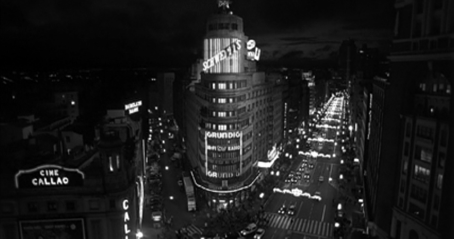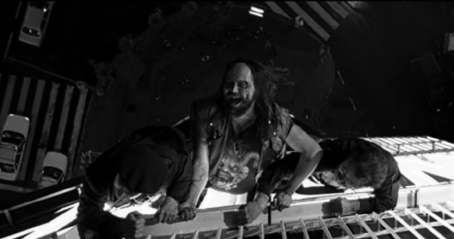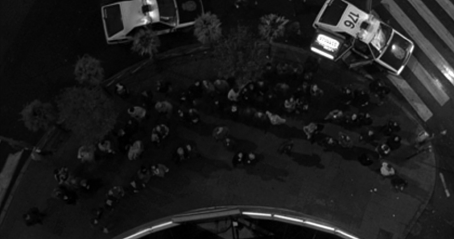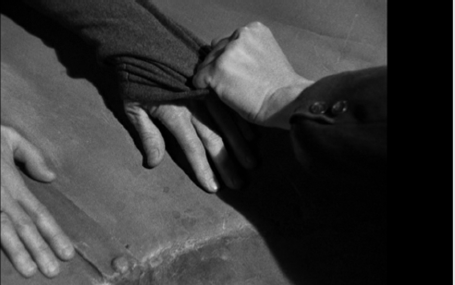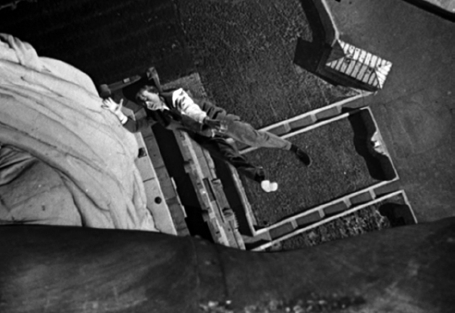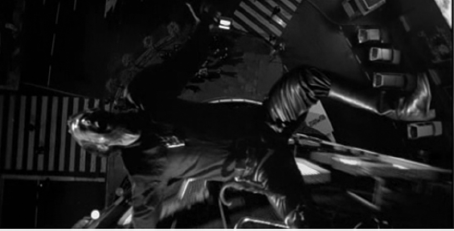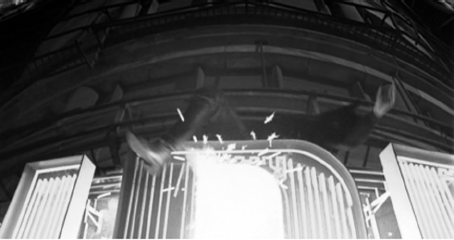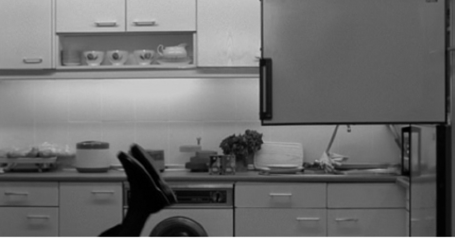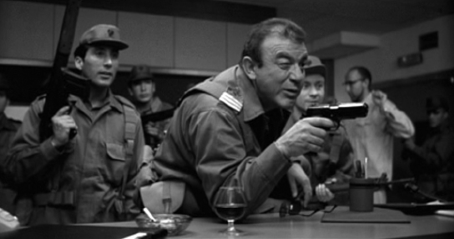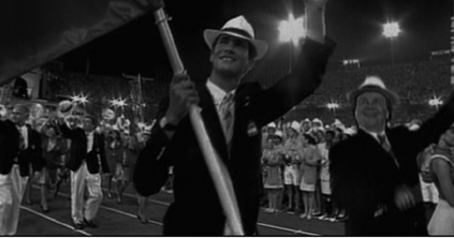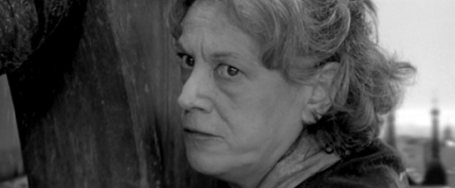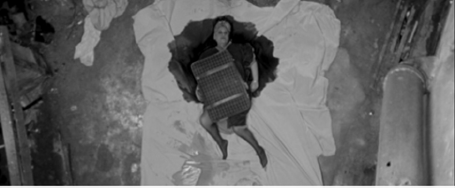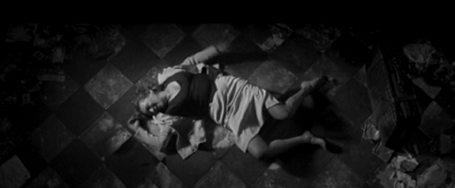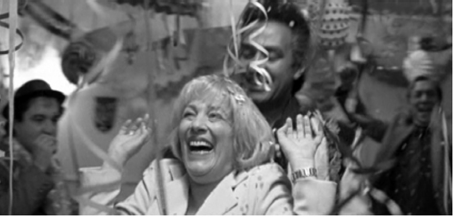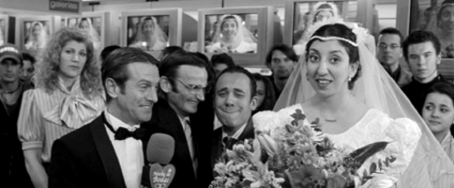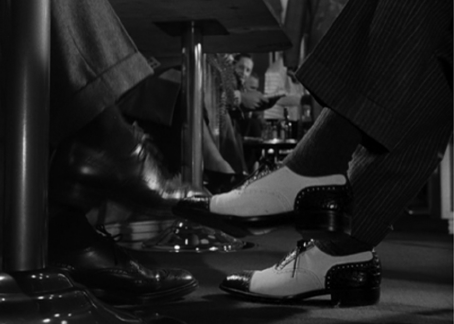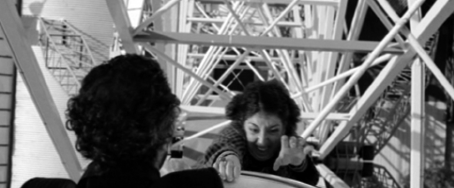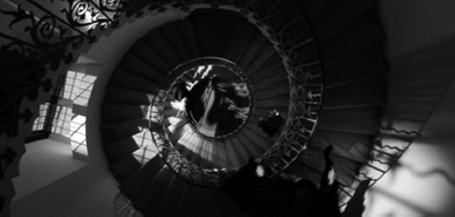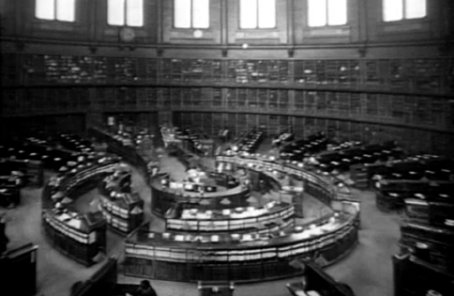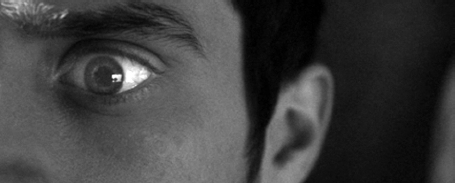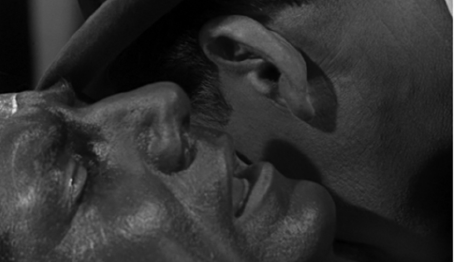I. INTRODUCTION: AN OPENING SHOT OF ARANTZAZU IN EUSKADI
On the DVD director’s track for his film Día de la Bestia (Day of the Beast, 1985) Álex de la Iglesia says that he insisted on getting an opening shot at the Arantzazu Sanctuary in northern Spain despite his producer’s objections that it was not worth the trip up there.1 The rest of the complex opening scene was constructed on a film set in Madrid. Because of a legendary sighting of the Virgin by a Basque shepherd, Arantzazu has been a pilgrimage shrine since the sixteenth century. The existing stone basilica, a beautiful modern structure dating from 1951, represents the ancient roots of Catholicism in Euskadi, the Basque Country.2 On the one hand the Arantzazu shot may remind us that De la Iglesia, whose last name means ‘of the church’, was born and raised in the Basque country, in Bilbao, its major industrial city. He studied philosophy there at Deusto, a prestigious Jesuit college. To recall, Hitchcock was also educated by the Jesuits, an order founded by Ignatius of Loyola in northern Spain. Hitchcock even counted the number of churches in his films – fifteen – as confirmation of a religious leitmotif in them (see Fernández Cuenca 1974). Yet in insisting on filming on location at the Arantzazu Sanctuary, De la Iglesia asserted something more than a respect for his own roots. He invoked the force and mystique of cultural icons – religious or secular – and foreshadowed the crucial role that a sense of place, cinematographically understood via mise-en-scène, would play in his films and artistic vision. As in the inclusion of churches, De la Iglesia followed in Hitchcock’s path. Most significantly in Day of the Beast and later in La comunidad (Common Wealth, 2000) he adapted Hitchcock’s famous climactic scenes on monuments. Indeed he once told me in an internet chat sponsored by the Spanish newspaper El Mundo that he ‘stole’ the climax of Common Wealth, a fall from the beaux art statue on top of the BBVA Bank in Madrid, from Hitchcock. In this chapter we will explore how De la Iglesia referenced this element of Hitchcock’s aesthetics, as well as many others, to build a crossover career in Spain, the US and the UK.
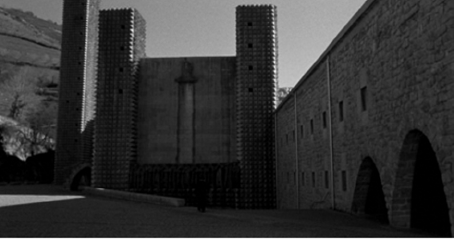
Establishing shot from Day of the Beast of the Arantzazu Sanctuary in Oñati, Gipuzkoa, Spain.
Like Almodóvar, Álex de la Iglesia (b.1965) never went to film school, but learned filmmaking by studying others, Hitchcock above all, and then experimenting, inventing the means to get the shots he wanted. A child of late Francoism who lived through the Transition, De la Iglesia received his early cinematographic education through State TV.3 His father was a professor of sociology at Deusto, and a film and theatre critic for La Gaceta del Norte. Eschewing soccer, the whole family gathered to watch movies together. For ‘good’ films, such as John Huston’s Freud (1962), which De la Iglesia saw at age five, sometimes the viewing was obligatory, but it was also permissive, as he was allowed to see even those films rated for 18 years and up. Television marked his life, especially the toughest blows. When he was twelve his father had a heart attack and died while they were watching the dubbed British sit-com Un hombre en casa (Man About the House, 1973–1976).4 De la Iglesia notes that Carl Theodor Dreyer’s La palabra (Ordet, 1955), a film about faith and miracles, became ‘an essential film in my life’, since he watched it with his mother and brother right after his father had died (Angulo & Santamarina 2012: 102). Later, while he was still in high school, De la Iglesia received ‘an electric shock to the neurons’ when he attended a film series called ‘The Essential Hitchcock’ of remastered copies of Hitchcock’s classics in a commercial theatre in Bilbao (Angulo & Santamarina 2012: 124–5). The high quality, especially because of Technicolour, so surpassed anything he had ever seen that it motivated him to draw and publish a fanzine with friends. They dedicated the first issue to Vertigo.
Both Hitchcock and De la Iglesia could be considered what we call today in reference to technology, early adopters or technophiles. Hitchcock, for instance, did a 3-D version of Dial M for Murder, which was one of the first 3-D films intended to be shown in Spain.5 De la Iglesia evokes this Hitchcock film, whose Spanish title was Crimen perfecto in his own Crimen ferpecto (Ferpect Crime, 2004). With Day of the Beast De la Iglesia became among the first in Spain not just to incorporate digital effects and complicated make-up, but also to make a digital master of a whole film. His first film, the short Mirindas asesinas (Killer Mirindas, 1991), showed both his general interest in the media and a penchant for the thriller genre.
II. SITUATIONAL HUMOUR IN KILLER MIRINDAS: A GUY WALKS INTO A BAR IN ERANDIO
Álex de la Iglesia made his first film, the twelve-minute black comedy Killer Mirindas, in 1991 in the Basque country, in Erandio. He co-wrote it with Jorge Guerricaechevarría, a long time friend from his early school days, with whom De la Iglesia would go on to co-write almost all of his subsequent films. Together the pair scrounged the money for the short at a party by pretending to be a theatre troupe (see Vera et al. 2002b: 39).
Killer Mirindas tells the story of a guy who goes into a bar for Mirindas, a Spanish orange soft drink. When the bartender and patrons do not understand him as literally as he expects, he morphs into a serial killer. In the first confrontation the sad sack protagonist (Alex Ángulo) tells the bartender (José Antonio Alvarez) to give him a Mirinda. When the bartender asks him to pay 120 pesetas, the man argues that he had asked the bartender to give it to him, not to charge him for it. He takes out a huge gangster’s gun and shoots the bartender. The casuistry of the argument reflects De la Iglesia’s Jesuit education. The killer then asks a poor guy (Saturnino García), trembling as he sits at the bar drinking coffee watching the mayhem unfold, to serve him another Mirinda. The hapless chap does as told, goes behind the bar and begins to serve as a bartender. Then the killer asks a different patron who was talking on the telephone (Oscar Grijalba) if he had the time. When that patron does not take the question seriously, the killer shoots him, too. Finally, a dapper man (Ramón Barea) comes into the bar excited after a good day and orders a drink from the substitute bartender. He turns on a small TV set on the bar and tunes it to watch bullfighting. Blithely intent on the TV screen, he ignores the killer’s requests for the time and a light for his cigarette. The killer takes out his gun but holds his fire. A deep focus shot shows the situation in spatial planes. In the foreground the bullfighting fan’s gripped immersion in the television leaves him oblivious to the body of the dead bartender splayed out over the bar, and to the killer in the background. The bullfighting enthusiast gets up, tells the bartender to put the drink on his tab and walks out. The killer drinks more sodas and then leaves without killing anyone else.
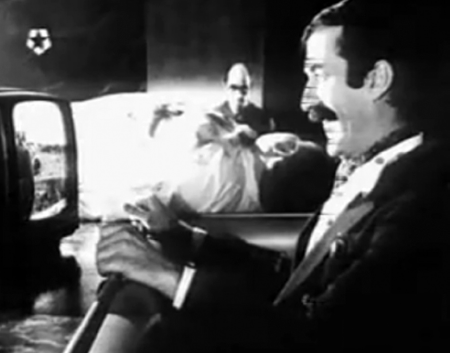
The dapper client (Ramón Barea) watches a bullfight on the bar’s TV oblivious to dead bartender or the killer (Alex Ángulo) in Killer Mirindas.
The narrative of the short has a classical structure that plays like a variation on the Conde Lucanor story from which The Taming of the Shrew derives.6 To recall, in that tale a young husband orders a series of animals to bring him water, then kills them when they do not. Finally he orders his headstrong bride to bring him water and she does. The repetition of requests in Killer Mirindas leads the viewer to expect that every one will do whatever the irrational killer orders. However, in Killer Mirindas the power of television changes the dynamics. The short shows both De la Iglesia’s concept of comedy as situational, which he elsewhere argues he took from Hitchcock, and his ironic placement of the screen within the screen. The short film comments on how television and popular culture has a pacifying effect on Spaniards. Marshall McLuhan called this media’s ‘cool’ effect. The bullfighting preference not only makes the dapper guy an archetype of Spanish males but they also characterise the inheritance of state-controlled Spanish cultural production in the 1980s. According to La cultura española durante el franquismo (Spanish Culture during Francoism), edited by by Manuel Alcalá, Norberto Alcover Ibáñez and the Equipo Reseña, Franco’s regime gave the people soccer, bullfighting and consumerism – ‘para el pueblo, el fútbol, toros y consumo’ (‘for the people, soccer, bullfights and goods to buy’) as the slogan went – while ignoring the creative potential of the medium (1977: 212). The emphasis on media history, through the representation of the effects of television in film, reappears at important junctures throughout De la Iglesia’s career.
Killer Mirindas has the situational humour that Hitchcock deployed in his television series Alfred Hitchcock Presents. In ‘Lamb to the Slaughter’, for instance, a mild mannered housewife makes an unlikely assassin of her husband. De la Iglesia adapts an archetypical humorous situation – so many jokes begin with ‘A guy walks into a bar’ – through mise-en-scène using elements of local specificity; that is, a bar in Erandio that serves a typical Spanish soda.
III. CAPTURING DARK HUMOUR IN POLITICAL TERRORISM IN ACCIÓN MUTANTE : HOW A POLICEMAN FROM OUTER SPACE CONVINCED ALMODÓVAR TO BACK DE LA IGLESIA
Like Hitchcock, De la Iglesia came to filmmaking with a design background. Hitchcock’s was in artistic design; De la Iglesia’s was in graphic arts, drawing comics for publication, then later in artistic design.7 His first cinematographic jobs were as artistic designer for Pablo Berger’s short Mamá (1988), then for Enrique Urbizu’s feature film, Todo por la pasta (Anything for Bread, 1991). These were not common avenues of entrée into filmmaking. However, because of his strong drawing skills, honed through the crafting of individual comic panels, De la Iglesia took Hitchcock’s characteristic working method to heart. He storyboarded almost everything, certainly all action scenes, which was not the usual method in Spain. He began doing this for his first feature film, a science fiction comedy, Acción mutante (Mutant Action, 1993).
De la Iglesia’s debut was an exceptional project for Spanish cinema. Given the high budgets and technical expertise necessary for special effects, in the 1990s science fiction was made in Hollywood, seldom in Spain. Pedro Almodóvar had seen and liked Killer Mirindas and contacted De la Iglesia with a tentative offer to produce his next short at El Deseo, the production company of Pedro and Agustín Almodóvar. De la Iglesia sent them a script for a short called Piratas del espacio (Space Pirates). The project’s originality and its unique sense of humour led them to sign on as producers, first for a three-part television series based on the story, then two years later, for its revision as the feature film Mutant Action.8 This marked one of the first instances in which El Deseo moved beyond producing only Pedro’s films to support promising new filmmakers. Mutant Action, which was made for about $2.5 million, had all the characteristics of what would become a cult film.
Set in a future world ruled by good-looking people, the film tells the story of the kidnapping of the daughter of Orujo, a wealthy executive, by a terrorist group, the mutants who seek to assert the rights of the ugly. Ramón Yarritu (Antonio Resines), the group’s leader, tries to kill the other members of his gang and keep all the ransom for himself as they escape from the police in a spaceship. The caper ends abruptly when they crash into Axturiax, a planet where no woman lives. Though played as a dark comedy, Mutant Action’s plot parodied real-life historical and political events – that is, the ETA kidnappings of businessmen and politicians for ransom that were taking place in the Basque country at that time. The characters’ names, in the suffix ‘ritu’ for example, and the planet’s spelling with two ‘x’s scan as Basque. The industrialist’s name, Orujo, evokes Galicia, region in northwestern Spain, and yet another distinctively Spanish beverage like the Mirinda.9 Orujo is a traditional Galician liqueur made from the residue of wine production.10 In the early 1990s a humorous film about a kidnapping by Basques was still possible – that is, a tale of revenge against an industrialist’s family could generate sympathy.11 Everything changed in 1997 with the kidnapping and killing of the young political deputy Miguel Ángel Blanco which mobilised Spaniards for the first time to protest against ETA in mass demonstrations in major cities across Spain. By then Mutant Action was doubly politically incorrect as it camped up both violence against women and terrorist kidnapping.
In 1993 Mutant Action won three Goyas, for special effects, make-up and production. Though this was a strong national debut, the film received limited international distribution until its rerelease a decade later. The style of Mutant Action, as well as the national specificity of the story that alluded to Spanish political events, made De la Iglesia’s first film an acquired taste.
Although Mutant Action could not be further from Hitchcock’s genre preferences, or the general Almodóvarian typology either, as a career step this debut film did follow the Hitchcockian model of beginning filmmaking through design.12 De la Iglesia created extravagant costumes for a terrestrial wedding scene, as well as a bizarre extra-terrestrial world, on a shoestring budget. The mutants, sitting on platforms suspended by strings, float around in a lotus position looking like the Fates of Goya’s black painting ‘Las Parcas’ (‘The Fates’, 1820–23). Like Hitchcock he also identified a group of other talented artists with whom he would work repeatedly throughout his career. José Luis Arrizabalaga and Arturo García, co-artistic directors on the film, tell how De la Iglesia imagined and then created a fantastic policeman to convince Almodóvar he could carry off the film. He then went to El Deseo in Madrid with still photos of the policeman he had taken on the streets of Bilbao. When Almodóvar was still doubtful, De la Iglesia found an extremely tall friend, dressed him in the policeman’s costume, and sent him into the El Deseo offices (see Vera et al. 2002b: 59). It is ironic that the Almodóvars became believers in De la Iglesia’s abilities and artistic vision through the real-life visit of a fantastic, larger than life, policeman. Famously Hitchcock’s father traumatised him as a youth with a visit to the police station (McGilligan 2003: 7–8).
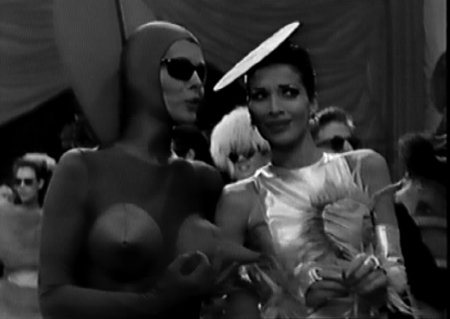
The extra-terrestrial costumes for a terrestrial wedding scene in Mutant Action.
IV. REACHING FOR THE HEIGHTS OF VERTIGO AND SABOTEUR, DANGLING FROM THE ICONS OF MADRID IN DAY OF THE BEAST
De la Iglesia’s second feature film, Day of the Beast, was even more ambitious in artistic design and mise-en-scène than Mutant Action. He called upon his knowledge of Hitchcock to reach a wider audience, and of all of his films Day of the Beast is the one that most directly alludes to specific scenes and techniques from Hitchcock films. Moreover De la Iglesia attributes the dark sense of humour in this film, which was marketed as ‘una comedia satánica’ (‘a satanic comedy’), to Hitchcock’s concept of comedy. Close analysis of Day of the Beast and the criticism that it provoked shows the pivotal role Hitchcock played in transforming De la Iglesia’s career from that of a marginal cult director to a mainstream commercial one.
Day of the Beast tells the story of Angel Berriartúa, a Basque priest and Jesuit theologian, played by Alex Ángulo from Killer Mirindas, who discovers a prediction of the Apocalypse, according to which the world will end in Madrid on 25 December 1995 when the Devil will appear and kill a baby. Signs of impending doom are already apparent in how vigilantes are torching immigrants in the streets and tagging the area with the slogan ‘Clean Madrid’. The priest tries to avert total catastrophe by confronting the Devil. To invoke his presence, Berriartúa commits evil deeds on purpose. He curses a dying man, robs a suitcase and self-mutilates the soles of his feet in the sign of the Cross. To understand the dark side, he teams up with José María (Santiago Segura), a record store clerk and heavy metal fan. Together they kidnap Professor Cavan (Armando de Razza), a television personality with a programme on the occult, to force him to teach them how to summon the Devil’s presence. When they conduct ancient rituals in Cavan’s apartment, the Devil appears as El Gran Cabrón, a huge goat. The trio escapes out the window onto the Capitol building’s facade. A chase ensues throughout Madrid until they spot the almost completed KIO twin towers. They interpret the profile of these skyscrapers that lean inward towards each other as the image of the Devil’s signature, a cloven hoof. They rush to engage him there. In an ensuing battle on the rooftop the Devil throws José María off the building to his death. Meanwhile the ‘Clean Madrid’ vigilantes set fire to the homeless who have sought refuge at the ground level of the construction site. The priest saves the baby of a homeless woman while Cavan suffers severe burns when he tries to staunch the flames. Reminiscing some time later in the Retiro Park, Cavan and the priest look like scruffy homeless people, too, as they incline their faces disfigured from the fight to take the sun on a bench under Benlliure’s statue ‘The Fallen Angel’. They lament that no one else understands that they saved the world.
Day of the Beast was wildly successful both among Spanish critics and at the box office, especially among younger viewers. It won six Goya awards, including that for Best Director, and catapulted De la Iglesia’s commercial career to a different level. For most of the public the film characterised his style for years after. He received adamant requests from his fans for a sequel, which he refuses to do.13 Reflecting its attraction for a young, hipper audience and its value as a career-building model, Day of the Beast became the subject of the second volume of Como hacer cine, a ‘how-to’ guide for aspiring Spanish filmmakers. In the book’s introduction De la Iglesia explains the origin of the idea for the film, marketed as ‘a satanic comedy’, and attributes his concept of comedy directly to Hitchcock:
The idea of combining an apocalyptic horror story with a comedy was original, but even more original was to take the story seriously. I believe that the basis of comedy is a serious and rigorous treatment. The characters never should laugh at what is happening, their life is tragic and conflicted – if it isn’t, there isn’t a story. It’s the situation that appears comic to the eyes of a third person. However more terrifying the situation in which the characters are involved, ever more entertaining it’ll be to see them get out of it. We find the key to this in a phrase from Hitchcock speaking of Vertigo: a common man inserted in a tremendous story. (Vera et al. 2002b: 9)
There is probably no situation or leitmotif more characteristic of Hitchcock’s cinema than the chase that ends in danger at great heights. Even those whose business is manoeuvering through Wall Street can list the films in which they occur – Saboteur, To Catch a Thief, North by Northwest, and Vertigo – as did H. Rodgin Cohen, profiled in 2009 as ‘The Trauma Surgeon of Wall Street’ in the New York Times.14 The two climatic confrontations on Madrid monuments, first, on the Schweppes sign on the façade of the Capitol Building, and second, on the top of the KIO Towers, are iconic Hitchcockian moments in Day of the Beast. Although the Capitol Building and the KIO Towers were identifiable landmarks in Madrid before De la Iglesia set key scenes on them – even if the Capitol building was known primarily as just another movie theatre and hotel on the Gran Vía, and the KIO Towers were seen part of an expanded business district on the Castellana marked by foreign investment – the film singled them out and transformed them into icons of their respective environments.15 As Juan Manuel de Prada argued in his article in a special issue of Nickel Odeon on Madrid and the movies, De la Iglesia’s film made its denizens see the city anew: ‘Seldom has Madrid been depicted in such a hallucinogenic manner and metamorphosed into a city with laws on the margins of physics and reason’ (1997: 196). The level of ambition in these scenes on transformed landmarks – that is, to transport the viewer beyond the laws of physics and reason – makes it worth interpreting these Hitchcockian allusions to climatic scenes on heights in detail.
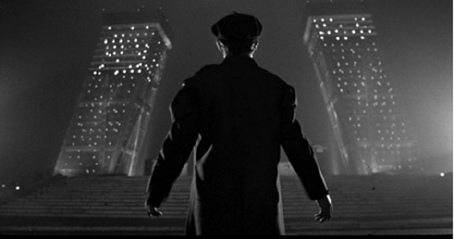
In Day of the Beast Father Berriartúa (Alex Ángulo) stands before the KIO Towers in Madrid acknowledging them as the sign of the Devil.
Professor Cavan, Father Berriartúa and José María climb out the window of Cavan’s apartment in the Capitol Building onto the Schweppes sign to escape the Devil whose presence they conjured and who is now chasing them. In a segment of an interview entitled ‘Vértigo’, De la Iglesia explains that during the actual filming of the sequence in Madrid, Armando de la Razza who plays Professor Cavan was genuinely terrified and kept saying he had vertigo:
The Capitol Building on the Gran Vía of Madrid, given landmark prominence in Day of the Beast.
In the sequence on the sign Armando de la Razza had awful vertigo and I was particularly cruel with him. But I think that it was worth the effort because I wasn’t going to ruin a whole sequence because Armando had vertigo. He began to say that he wasn’t going to act, and I told him that I didn’t care if he didn’t act, that he only had to be there and pretend like he was talking. Then I began to film while he was saying, ‘I have vertigo, I have vertigo.’ And that’s what he’s really saying. I dubbed him later. (Vera et al. 2002b: 28)
These comments, which also speak to how a director should assert his will over actors, connect the film in terms of the situation most directly to Vertigo, and Scottie’s fear of heights as depicted early in that film. De la Iglesia’s dubbing is so effective that it is difficult for even a careful viewer to tell if Armando is in fact saying ‘vertigo’. That De la Iglesia tortured his actor to get the reaction he wanted is entirely plausible, and a lesson for up and coming young directors. Although Armando’s desperation in the situation is evident, so, too, is the articulation of De la Iglesia’s desire for viewers to see him as a Latin Hitchcock. Indeed De la Iglesia ‘dubbed’ Vertigo into the mise-en-scène as much as he erased its presence in the soundtrack. The film cuts from close-ups of the trio escaping out the window of Cavan’s apartment onto the huge neon Schweppes sign on the façade of the Capitol Building, to progressively longer and higher-angle shots that show the Callao movie theatre and the night-time Gran Vía boulevard. These initial shots also position the characters as if they were in dark outer space as their backdrop is a giant billboard with an ad for Kodak featuring a man walking on the moon. The composition not only breaks the laws of physics but also imprints Day of the Beast with De la Iglesia’s own signature, a connection to the outer space mise-en-scène of Mutant Action.
After these establishing shots the perspective shifts to a vertigo shot that shows the trio from above. When the madly laughing and footloose José María, who appears to enjoy the danger of the situation, slips and falls, as had Scottie’s police partner in Vertigo’s initial chase scene, Cavan and Berriartúa barely catch José María’s hands. He is left dangling. When they pull him up, he manages to grab on to the sign again. The night-time scene has a graphic minimalist quality as the coloured neon bars of the Schweppes sign echo the stripes of the crosswalks painted on the street far below. This design or pattern repetition increases the vertigo effect, especially as the coloured lights pulse, recalling Scottie’s dream.16 The two shots are classic examples of the Hitchcockian blot, named by Slavoj Zizek, ‘to describe a characteristic visual design of Hitchcock’s films in which a place in the visual field, usually at the central, vanishing point of the image, contains a privileged “object” that functions as a kind of stain or blot that cues the spectator to the disruptive, threatening presence of the shadow or chaos world that subtends the everyday world of appearances and social respectability’ (quoted in Allen 2007: 205). The Schweppes sign above, and the plaza gathering area for the movie theatre spectators below, produce a dynamic tension as they both ‘centre’ the scene, or produce a vortex, and push the signifiers of urban capitalism into the spectators’ consciousness. As Malcolm Compitello explains when he discusses this scene among others in ‘From Planning to Design: The Culture of Flexible Accumulation in Post-Cambio Madrid’, Day of the Beast ‘articulates a vision of urban consciousness that is cognizant of how capitalism forms space as well as how it intervenes in the dialectical tension between space and place that Harvey masterfully unravels in Justice, Nature and the Geography of Difference’ (1999: 205–6).
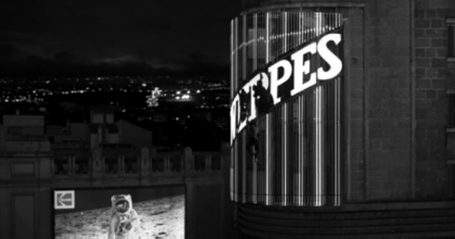
In Day of the Beast the moonwalker on a Kodak billboard adds to the sense of being in outer space to the plight of Professor Cavan, Father Berriartúa and José María on the neon Schweppes sign.
The madly laughing José María (Santiago Segura) in Day of the Beast is about to let himself slip and plummet over street markings, motifs that recall Scottie’s dream sequence in Vertigo.
The spectators in the ‘Hitchcockian blot’ of Day of the Beast.
No longer the proper sleeve length: Barry Kane grasps the villain Frey’s sleeve as it gradually tears away in Saboteur.
Frey plummets off the Statue of Liberty in Saboteur.
To return to our close analysis and more specifically to Hitchcock, José María in his mad state or heightened sense of ‘urban consciousness’ falls again, this time taking Cavan down with him and leaving the trio dangling in a row. This improbable result and alignment, more commonly found in a comic book, changes the dynamics and the tone of the sequence. Significantly, with Cavan now the low man on the totem pole, the film shifts from Vertigo to Saboteur (1942). To recall, in the iconic climax of Saboteur on the Statue of Liberty, the jacket sleeve of villain Fry (Norman Lloyd) gradually tears away from the grasp of the hero Barry Kane (Robert Cummings) and Fry plunges to his death. For this, the most ambitious shot of the film, Hitchcock invented a complicated mechanised platform to stage the fall. In Day of the Beast Cavan assumes the position of the villain Fry. From an overhead shot, the film cuts to a point-of-view shot of Cavan looking down at his feet dangling. Close-ups of Cavan’s hand slowly slipping out of José María’s grasp are intercut with shots of the gawkers, including Asian tourists looking up at the scene from the street. Analogous to Saboteur, Cavan’s desperate suspenseful grasp and screaming plunge are shown via a bird’s-eye view. In Day of the Beast the converging patterns on the street give the effect of a vortex into which a splayed-out man tumbles. Unlike the Saboteur villain who dies in the fall, Cavan is saved as he bounces onto a lower sign, creating sparks that radiate around him as in a comic book image. The scene ends as Cavan looks down at the police and his buxom girlfriend Susana (María Grazia Cucinotta) who have arrived to rescue him. José María and the priest climb off the building into another apartment where a little girl is watching a Christmas television show. Reflecting De la Iglesia’s take on Hitchcock’s sense of comedy, that humour is created when a desperate situation is taken seriously, she mistakes the bedraggled, scruffy José María for ‘Papa Noel’. In its narrative and in its emphasis on design, the climatic scene ‘Colgados’ (‘The Hanging Ones’) reveals its antecedents in Hitchcock’s archetypical scenes.
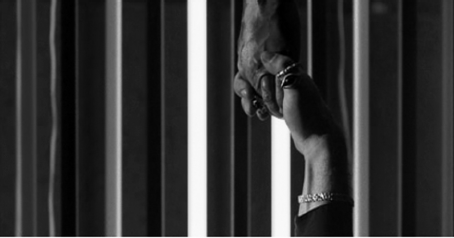
Cavan’s hand slowly slips out of José María’s grasp in front of the Hitchcockian motif in Day of the Beast.
Cavan’s fall in Day of the Beast.
Cavan’s comic book bounce with sparks that saves him in Day of the Beast.
As we have seen, allusions to graphic novels or comic books interrupt this key sequence and change its tone. This comic overlay, which reflects De la Iglesia’s passion for sequential art developed over many years, represents his unique interpretation of Hitchcock. In La bestia anda suelta: ¡Álex de la Iglesia lo cuenta todo! (The Beast is Loose: Álex de la Iglesia Tells All!, 1997), an interview book by Marcos Ordóñez, De la Iglesia recounts how he not only avidly consumed his brother Agustín’s collection of comics, but also how he associated Hitchcock with the world of graphic novels of his youth. He tells how the two brothers planned a special issue of their fanzine ‘No’ to show comparisons between Hergé, the creator of the Tintin series, and Hitchcock:
The relationship between Hergé and Hitchcock is exciting to explore as we end up discovering tons of similarities. From their character, two Puritans with a hidden dark side, full of obsessions and mysteries, to the most insignificant stylistic forms. Hatred of birds, for example, is a constant in Hergé and in Hitchcock. And from the beginning, from Hitchcock’s British period, from Hergé’s first albums. From the birds of ‘Tintín in America’ to the magpie of ‘The Jewels of Castafiore’
[…] It is fascinating how he manages to construct a plot that is sustained by a succession of minimal, insignificant intrigues … A step that breaks time and again, a telephone line that always connects to the wrong number … All of that is the essence of Hitchcock. There’s the most pure Hergé, the essential Hergé, of the ‘Jewels’ and ‘Tintín in Tibet,’ another great masterpiece, and later there are, of course, the great adventures: ‘The Scepter of Ottokar’, ‘The Tornasolo Affair’ … ‘The Tornasolo Affair’ is ‘North by Northwest’. It is the height of action comedy, and the storyboarding is very similar. And ‘39 Steps’ and ‘Foreign Correspondent’ … also are pure Tintín. It’s impossible not to think of Tintín seeing Joel McCrea pursuing, through a wall of umbrellas, the assassin who shoots with his pistol hidden in a camera, an image that … yes, also appears in ‘The Scepter of Ottokar’.
Pure Tintín, except in respect to the relationships with women. Although if one were to look for a feminine partner for Tintín I think that his relationship would be like that of Robert Donat and Madeleine Carroll in ‘39 Steps’: handcuffed and quarrelling during the whole episode. (1997: 43, 45–6)
This extensive comparison shows that De la Iglesia ‘read’ Hitchcock through the filter of Tintín. From his adolescent years on he saw them as superimposed visual storyboards, composed of ‘dramas of minimal actions’. They served as foundational texts for his filmmaking.
The two climaxes on heights from Vertigo and Saboteur evoke very different main themes for these respective Hitchcock films. According to Richard Allen, the vertigo shot represents ‘the implosion of the boundary between self and world’ (2007: 207). Moreover, Scottie’s fear of heights in Vertigo is often interpreted psychoanalytically as a manifestation of a psychic crisis over his masculinity. Yet Day of the Beast is devoid of Vertigo’s romantic tensions. Father Berriartúa is not a romantic hero. Furthermore as Marsha Kinder points out in Blood Cinema: The Reconstruction of National Identity in Spain (1993), the sexual politics of Day of the Beast are disturbingly misogynistic. The major female characters establish a Manichean paradigm; either they either perpetuate sexual violence in the case of the rooming house owner Rosario (Terele Pavez), who acts as a castrating mother figure when she comes at Father Berriartúa with a shot gun, or they fall victim to violent sexually inflected crimes in the cases of Professor Cavan’s girlfriend Mina (Nathalie Seseña), and the daughter of the rooming house owner, both of whom are accosted in order to draw blood for demonic rituals. Nonetheless De la Iglesia’s comment that he wanted to force the actor Armando de la Razza to suffer in order to get his shot suggests a different psychoanalytical interpretation for this scenario. The paradigm derives not from the hesitations and romantic longings of Vertigo, but from the excruciating drama of the Statue of Liberty sequence of Saboteur. To recall, Saboteur tells the story of a young factory worker Barry Kane wrongly accused of sabotage. He becomes a fugitive, while pursuing Fry, the real perpetrator of the crime. Following the clue of a letter he saw addressed to Fry at Deep Springs Ranch, he goes there and meets the owner Tobin (Otto Kruger), who denies knowing Fry, but who is in fact the kingpin in the whole scheme. Tobin turns Barry over to the police, but he escapes. While on the lam he meets up with a girl, Pat (Priscilla Lane), whom he forces to accompany him. They seek refuge in a train car full of circus performers, who prove to be generous souls and good judges of character. In a democratic moment they vote to hide the couple from the police. The chase ends on the crown of the Statue of Liberty where the villain Fry, despite an attempt by Barry to pull him back by his sleeve, falls to his death.
The gradual tearing of Fry’s sleeve is generally seen as one of the supreme illustrations of Hitchcock’s mastery of suspense. Nonetheless, when Truffaut praised the ‘climatic force in your way of going from the smallest to the greatest, from the trivial to the all-important’ Hitchcock rejoined with his doubts about whether he had reached the highest possible climax: ‘Still, there’s a serious error in this scene. If we’d had the hero instead of the villain hanging in mid-air, the audience’s anguish would have been much greater’ (1984: 147). In Hitchcock’s Romantic Irony Richard Allen observes that in Saboteur the conspiratorial ringleader Tobin is one of a series of dandy figures in Hitchcock’s films, like Vandamm (James Mason) in North by Northwest, and that furthermore, ‘The “perversity” of the figure of the dandy then issues in part from the resulting fusion of masculine and feminine traits that bestow upon him a kind of hyperbolic, almost demonic knowledge of and power over another’ (2007: 84). Since Fry is Tobin’s lackey, he represents a surrogate for the dandy and his fusion of masculine and feminine traits. Questions about his sexuality preface the final scene since Fry rebuffs Pat’s flirting in the interior observation deck of the Statue of Liberty before Barry and he stage their final scene on the crown’s exterior. There is no strong masculine hero in Saboteur. Speaking to Truffaut, Hitchcock confessed his supreme disappointment with the casting of Robert Cummings as Barry because the actor had little gravitas. Barry/Cummings’ weak screen presence as protagonist deflects our attention elsewhere and opens Saboteur, and by extension, Day of the Beast, to an interpretation in terms of a gender continuum. Although Allen looks to Tobin as a dandy, Boris Izaguirre in El armario secreto de Hitchcock (The Secret Closet of Hitchcock, 2005) detects homoeroticism, ‘a classic homosexual erotic dream’ in Barry the handcuffed fugitive finding ‘a mature, solitary, blind protector’ in Philip Martin’s (Vaughn Glaser) cottage (2005: 174).
To return to Day of the Beast, Cavan’s fall resembles Fry’s in that in both cases spectators identify with the predicaments, but less so with these characters. As Hitchcock noted regarding Saboteur, the villain falls, not the hero. In Day of the Beast Professor Cavan acknowledges himself to be a charlatan, not trustworthy in his knowledge of the occult. He is moreover a foreigner representing the incursion of trash international media in Spain. Cavan is a dandy analogous to Fry, the pawn to a dandy in Saboteur.
It is fitting that De la Iglesia turned not just to Vertigo but also to Saboteur for his iconic climaxes in Day of the Beast, since Saboteur complexly entwines gender and politics. Since Hitchcock habitually claimed disinterest in political arguments for his films, few viewers recognise that Hitchcock intended to go beyond a generic defence of American values in Saboteur and specifically unmask pro-German Fascist elements, called America Firsters, in the US in 1941 (see Truffaut 1984: 145). Conversely, Day of the Beast has been read, with considerable difference of opinion, in terms of Spanish politics since its release. On the one hand, Marsha Kinder interprets Day of the Beast as a condemnation of the excesses of Socialist neoliberal policies that prefigured the change in government to Partido Popular (PP) and the right in 1996. For her the ‘Clean Madrid’ vigilantes represent the thugs of the Grupos Antiterroristas de Liberación (GAL) campaign in the Basque country, the covert war of Socialist prime minister, Felipe González; Cavan alludes to Berlusconi’s media empire; and overall ‘Madrid’s corruption is inextricably linked with the drive toward European convergence’ (1993: 21). On the other hand, Compitello takes issue with Kinder and argues that Day of the Beast is not just a political allegory but ‘truly radical’:
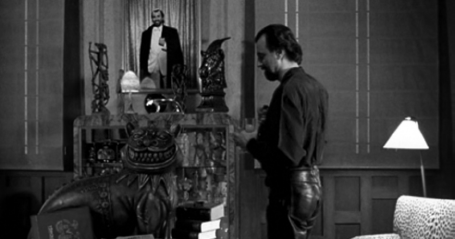
Professor Cavan, the dandy of Day of the Beast, in his apartment decorated in best internationalist, self-aggrandizing style of Berlusconi.
It articulates the processes that contribute to the urbanization of consciousness at a particularly important juncture in Spanish history. It is a resistance to the kind of political thinking that attributes all responsibility for Spain’s ills to the policies of the central government in Madrid and the corruption that ensued from those policies. While the Socialists bear blame for their policies that made land speculation profitable, others hold a great responsibility as well. By the time the movie was made, we must remember the right had held the reins of local government in Madrid’s municipal government as well as the government of the Comunidad de Madrid for some time. (1999: 213)
Compitello does not see the ‘Clean Madrid’ vigilantes as an image of the Socialist GAL secret police but as a possible transmutation of the PP’s vision of Madrid.
De la Iglesia’s later film Common Wealth supports the latter reading. Although Compitello makes a case for a more theoretical, overarching reading of Day of the Beast, as ‘a filmic challenge to the discourse of postmodernization’ (1999: 214), he too acknowledges the irony that the film as a successful commodity participated in the very process it critiqued.
In Saboteur the villain’s fall from (the Statue of) Liberty extends the ideological symbolism to the end. The film’s political effect, however, was quite different and focused on the lead up to the Liberty climax. The US Navy demanded the censoring of the image of their disabled ship Normandie lying in the New York harbour, with the cut to the villain’s smirk, as wrongfully implying that the Navy could successfully be targeted for sabotage on US shores (see Truffaut 1984: 146). These images were restored in a 1948 US reissue (see McGilligan 2003: 303). As we have seen in our Spanish reception chapter the film never even opened in Madrid until 27 December 1945, after the end of World War II. Even Fascist censors found it too incendiary for wartime.
For Compitello Day of the Beast images how ‘the role of urban planning is diminished under flexible accumulation’ (1999: 216) and through the transition urban planning becomes only urban design, especially through the transition between the two historical eras that the Capitol and the KIO Towers represent. Yet both Hitchcock and De la Iglesia excel in richly exploiting this element of design cinematographically. A close analysis of these scenes shows De la Iglesia’s aesthetic heritage and also reveals, when Hitchcockian criticism is taken into account, significant gender, political and ideological nuances in De la Iglesia’s film.
V. ONCE BURNED IN THE WEST, EVEN WITH SOME NORTH BY NORTHWEST: THE CROSSOVER DISASTER OF PERDITA DURANGO
The success of Day of the Beast brought De la Iglesia to the attention of Hollywood. The Spanish producer Andrés Vicente Gómez offered him the opportunity to direct a big-budget English-language crime drama, Perdita Durango (1997), after the veteran Spanish director J.J. Bigas Luna had left the project. Rosie Perez was already cast in the starring role. Like Rebecca, Hitchcock’s first crossover project, Perdita Durango was also an adaptation of a novel, in this case one of the road novels by Barry Gifford that was based on a real event in Austin, Texas. Gifford also co-wrote the film’s script as he had done when he worked with David Lynch on Wild at Heart (1990) in which Perdita Durango was introduced as a minor character.17 For De la Iglesia this film marked the first time he did not work from a script he had written. He would rue the day. Subsequently he complained that the script, even as reworked by David Trueba, did not represent his preferred point of view, that of a loser:
In fact, one of my biggest problems I had to confront was that the original novel of Perdita Durango didn’t tell the story of a downtrodden person, but of a hero. If the movie had been closer to my vision, I would have told the adventures of a poor disillusioned fellow who lives on the Mexican border, who they say practices santería, but who really doesn’t have any power. Nonetheless he finds himself caught up in a scheme and forced to simulate acts of witchcraft in front of a series of people. (Heredero 1997: 473)
The project presented multiple challenges. De la Iglesia not only had to insert himself into Hollywood cinema, to respect the classic Hollywood narrative arc, but also to represent a bilingual Latino perspective and direct an already established Latina star. This double bind was difficult for a Spaniard at first try. Whereas in Rebecca Hitchcock imported and staged a comfortably familiar British manor life in the US, in Perdita Durango De la Iglesia did not stage a Spanish or Basque mise-en-scène for Hollywood. The Spaniards De la Iglesia and Javier Bardem, in his first major acting role in English, immersed themselves in border culture.
The film tells the story of two psychotic killers, Perdita Durango (Rosie Perez) and Romeo Dolorosa (Javier Bardem) who meet, fall in love and undertake their illegal activities together on the road. Romeo, a witch doctor, leads santería rituals. In a state of possession he chops up a human cadaver, throws the limbs into a cauldron, and then blows blood from the brew onto the faces of the other attendees. Romeo also robs a bank dressed as the legendary Mexican wrestler and actor El Santo. To settle a large debt, Romeo agrees to drive a truckload of human foetuses destined for the cosmetics industry across the US/Mexican border to Las Vegas for his mob boss Santos (Don Stroud). Before setting off Romeo feels compelled to practice more human sacrifice in order to bless his trafficking mission.
Together with Perdita they randomly kidnap a pasty white teenage couple, Estelle and Duane (Aimee Graham and Harley Cross), vacationing in Mexico. Perdita rapes Duane who then is forced to watch Romeo rape Estelle. Perdita and Romeo take the couple on their journey to Las Vegas and continue to abuse them psychologically and sexually. Woody Dumas (James Gandolfini), a DEA agent, and the father of the kidnapped girl track the outlaws, but Reggie San Pedro (Carlos Bardem), Romeo’s cousin, is set up to settle scores. The mobster recruits Reggie to receive the contraband cargo for a handsome pay-off if he double-crosses Romeo. In a warehouse Reggie shoots Romeo and is himself shot by Perdita, who runs out when she hears an explosion. As Romeo lies dying, Dumas stands over him. In the final scene, in the version of the film shown everywhere but in the US, Romeo melds into the image of the soldier of fortune Joe Erin (Burt Lancaster) in the Robert Aldrich classic Vera Cruz (1954), a favourite western of his childhood. In Romeo’s imagination Dumas transforms into Ben Trane (Gary Cooper), another soldier of fortune in Vera Cruz who is revealed to be nobler and less materialistic in the film’s showdown.18 After Perdita sees Romeo’s body taken away in an ambulance, she strolls down the neon-lit Vegas boulevard.
Perdita Durango pays direct homage to Vera Cruz, as well as to a sheaf of other Hollywood movies – Orson Welles’ Touch of Evil (1958), Robert Aldrich’s The Grissom Gang (1971), Sam Peckinpah’s Bring Me the Head of Alfredo García (1974), Quentin Tarantino’s Pulp Fiction (1994), Oliver Stone’s Natural Born Killers (1994) and Robert Rodriguez’s From Dusk Till Dawn (1996), but only minimally to Hitchcock; yet a few allusions to North by Northwest do stand out. One, after Romeo and Perdita have raped Estelle and Duane, Romeo asks them sarcastically, ‘What are your plans for the future?’ The film cuts to a low-angle shot of a Saguaro cactus around which a jet plane’s trail circles. The image punctuates sex with modern transport just as the phallic entrance into the tunnel did at the end of North by Northwest, an ending that Almodóvar also cited in Labyrinth of Passion. Two, more generally the cargo that Romeo transports, foetuses, is a savvy joke on the Hitchcockian MacGuffin, the element that drives the action but is not important in itself. By diminishing the importance of the foetuses by making them only the MacGuffin, the film executes a double critique of major US cultural issues, that of abortion and the obsession with youth culture. These two Hitchcockian motifs are acknowledged in the opening title sequence. Three, in the turning point sequence when Romeo takes fateful possession of the truckload of foetuses in Tijuana the music on the soundtrack strongly alludes to the chase theme of North by Northwest.
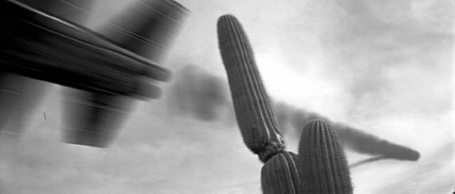
A jet plane circles around a phallic Saguaro cactus in Perdita Durango.
Like Hitchcock, De la Iglesia in Perdita Durango pushed the boundaries of sex and violence, mixed genres and incorporated humorous dialogue, but he couldn’t master the mix, especially the border culture. For an American audience, De la Iglesia did not get American pop culture right, particularly in his use of music. For instance the citation of the Tijuana Brass, as a favourite of Estelle’s father, is so over explained that it makes the scene itself lame rather than funny or parodic. Furthermore, though spectacular in his actions, a magnetic presence in the film, Bardem in his first English-speaking role is hard to understand, for example when he waxes philosophical about ‘big questions’, and is not convincing as a Latino either when he speaks Spanish with hints of a Castilian accent. More problematic, however, is the unsure tone with which the Latin culture of santería is presented. Carlos Heredero rightly observed to De la Iglesia himself: ‘It isn’t at all clear if the santería rites, with that excess of “gore” of the heart ripped from the cadaver, are filmed seriously and in a sensationalist manner or from an ironic and disbelieving perspective’ (1997: 493). Since all of these aspects – soundtrack, dialogue clarity and santería – come off as unnaturally forced, the film’s pace is plodding, rather than action-packed. When David Rooney first reviewed Perdita Durango for Variety, he called for ‘serious re-editing’, since ‘this trashy comic-strip saga of apocalyptic sex, violence and voodoo rituals is not quite fast or fun enough to fully satisfy in its present shape’ (6 October 1997).
This postmodern pastiche effectively underwhelmed an international audience, too. In Spain the ABC critic E. Rodríguez Marchante lamented ‘what a waste’ after he saw Perdita Durango at the San Sebastián Film Festival:
The great attraction of this festival, the return to the big screen of that winner Álex de la Iglesia, the most highly awaited film of the year, turns out to be, with a swift kick I’ll say, a chestnut filmed with utmost attention to detail: great actors, great shots, great visual pretensions, spectacular action, sex, violence, real life excess, Las Vegas … In sum, everything rolled into a big movie – all show, no content. (26 September 1997: 130)
In short, Rodríguez Marchante saw pure surface. Even though De la Iglesia has said on the DVD commentary track that he learned to be a better filmmaker from making Perdita Durango – for example, he definitely learned to manipulate more sophisticated tools such as specialised cameras used on helicopter shots – his first encounter with Hollywood did not go smoothly. Although the film was a box office hit outside of the US, the film hit a snag in the US. The executors of Burt Lancaster’s estate blocked its theatrical release citing a US law that images of deceased celebrities cannot be altered without the consent of their respective estates. Bardem could not supplant Burt in his heroic death scene. Trimark Films, which was set to distribute the film, would not pay what the Lancaster estate demanded. Hence for the US market the clip of Vera Cruz was removed, the title changed to Dance with the Devil (because, according to Barry Gifford, Perdita Durango was ‘too Hispanic and people wouldn’t know what the movie was about’) and the film went straight to video.19 Symbolising the film’s fate in the US market Perdita Durango indeed walked away disconsolately in the lights of the Vegas strip at the end. The fact that the cuts to the film varied so greatly across the globe also indicates that its cultural sensibilities – in terms of sex, violence and media references – were neither as finely tuned nor as commercially viable as Hitchcock’s were in his crossover to the US.
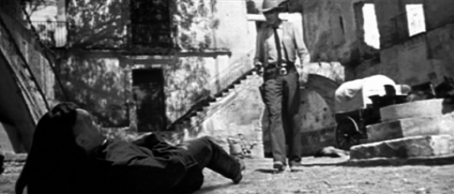
In the director’s cut of Perdita Durango Javier Bardem supplants Burt Lancaster in his dying role in Vera Cruz.
Perdita Durango (Rosie Perez) walks away disconsolately into the lights of the Las Vegas strip at the end of Perdita Durango.
VI. THE CRITIQUE OF SPECTATORSHIP AND HITCHCOCKIAN SERIOUS COMEDY IN MUERTOS DE RISA
I discovered the cinema through television, and this symbolizes a little my way of seeing things. (Álex de la Iglesia, interview, Heredero 1997: 469)
The legal issues around Perdita Durango as well as its lukewarm critical reception soured De la Iglesia on a cross-over career. He turned down offers to direct Alien IV and The Mask of Zorro. It was not until The Oxford Murders (2008) that he made another movie in English. Instead after Perdita Durango he returned to known territory, to Spain and Spanish television history, to make Muertos de risa (Dying of Laughter, 1999), the story of the comedy act of Nino and Bruno. With this film he continued to develop his own unique style, inflected by comic book art. One improbable comic book action scene occurs in Dying of Laughter when Nino’s mother discovers her dead cat in the freezer. She flops over dead backwards like a plank. Although Hitchcock, too, certainly had fun with frozen meat in the television episode ‘Lamb to the Slaughter’, these comic book scenes are too broad and parodic to be considered allusions to Hitchcock.
As I have argued elsewhere, the essence of Dying of Laughter is its serious reinterpretation of television history.20 Like Hitchcock in Rear Window and many other films, De la Iglesia critically explores the notion of spectatorship. In recreating television history, he underscores how the sense of a nation emerges now through spectatorship. Like Hitchcock he values the role of the spectator and appreciates popular culture.
Comic book action in Dying of Laughter: Nino’s mother flops over dead backwards like a plank when she discovers her dead cat in the freezer.
Dying of Laughter explores spectatorship through two significant scenes that negotiate national identity: one, the failed Tejero coup of 23 February 1981, and two, the 1992 Barcelona Olympics opening ceremony. In the first case a sergeant (Jesús Bonilla) just doing his duty occupies a television station. There he and his conscripted troops watch the violent takeover of the Congress, called F-23 in Spain, by Coronel Tejero, as well as an animated series, unfold on television. They fraternise with the television station workers and act like ‘good ole boys’, who are following orders, but who are not invested in overthrowing the State. In the second case, the character Nino is inserted into footage of the Olympic parade in the 1992 Barcelona Olympics as the Royal Family, and the world, watch in the stands. Both scenarios, which were situated at the moment Spain first entered the European Union, link spectatorship to issues of nationhood.
De la Iglesia continues to present his reinterpretation of Hitchcock’s notion of comedy as black humour. He takes seriously comic situations of ordinary types that grow out of all proportion. For instance in an early sequence the effeminate Nino performs in a down-at-heel bar to a rowdy troupe of soldiers who force him to interact with their mascot, a goat. He valiantly tries to sing on, but finally kills the goat, setting off a brawl. The soldiers set upon Nino and burn the bar down.
In Dying of Laughter the ‘good ole boy’ sergeant pauses for a whiskey, a smoke and some TV watching, as his troop takes over the television station during the F-23 coup in Madrid.
Nino as Zelig in Dying of Laughter, inserted into the opening ceremony parade of athletes, next to Prince Felipe de Borbón, as a member of the Spanish delegation during the Barcelona Olympics.
Dying of Laughter disappointed at the box office when it first appeared. However, its interpretation of the media has gained increased critical appreciation over the years. Also since Santiago Segura, known for his politically incorrect Torrente films, and the Gran Wyoming, who now has a TV talk show, have grown in popular consciousness, the film now ranks high in DVD viewings.21 In 2012 in Spain Dying of Laughter stood at number one among De la Iglesia’s films for box office returns (see Angulo & Santamarina 2012: 56).
VI. OUTWITTING THE TENANT BLOCK FROM REAR WINDOW TO COMMON WEALTH, STEALING THE MONUMENTAL CLIMAX OF NORTH BY NORTHWEST
De la Iglesia’s return to Madrid in La Comunidad (Common Wealth)22 was likewise a return to Hitchcock – to the genre of a suspense thriller, a Hitchcockian mise-en-scène, a mix of drama and humour, and a continued exploration of spectatorship. Filming in enclosed urban spaces, for this is ‘a suspense movie with only one set’ as De la Iglesia self-designates the film in the DVD liner notes, suggests the challenge Hitchcock met in Rope, Dial M for Murder and Rear Window. Indeed as he told Jesús Angulo and Antonio Santamarina, De la Iglesia and his co-scriptwriter Jorge Guerricaechevarría had Hitchcock in mind for the movie’s original concept: ‘The idea came about because suddenly Jorge and I reached the same conclusion as Hitchcock – that is, that the fewer elements you use, the more powerful the film is’ (Angulo & Santamarina 2012: 233). However, Common Wealth also looked back to other 1950s classics, specifically to the Neorealist urban setting, dark humour and oppositional politics of Marco Ferreri’s El pisito (The Little Apartment, 1958) and El cochecito (1960). Situating these films in the history of world cinema in his review of these Spanish films upon their release on DVD in 2005, Carlos Losilla argues in Dirigido that they should be considered more global than local, for Ferreri together with Antonioni, Fellini, Visconti and Bertolucci are ‘melancholy chroniclers of a bourgeoisie in the midst of extinction’ (2005: 71). De la Iglesia aspired with Common Wealth to a similar global profile and critical stance at the turn of the twentieth century. As it had been in El pisito the catalyst was again real estate.
Common Wealth tells the story of Julia (Carmen Maura), a forty-year-old real estate agent who discovers a cache of 300 million pesetas in the building of a Madrid flat she is showing, and where she stays illegally with her husband. Checking out the source of a rain of cockroaches onto their bed, she goes up to the attic flat with another tenant. They find a decomposed body; and she lifts a wallet from the body. Later using a map she found in the wallet, she returns to locate the money. She buys a 1950s-style plaid suitcase and stuffs the money into it. The other tenants of the building, who have been waiting for years for the old man in the attic to die to get his lottery winnings, band together and try every trick possible to get the money away from Julia. To get her drunk, the neighbours stage a party that only hops into action when she walks in. When she tries to leave the building with her suitcase of money, the tenant who accompanied Julia to discover the old man’s body, whom the other tenants therefore consider suspect, gets on the elevator with her. The elevator gets stuck between floors. He gets caught half in and out of the elevator and is cut in half when the cage falls. The police cursorily investigate the scene.
Periodically potential buyers arrive for a tour of Julia’s flat. By making scissors gestures, implying lesbian sex, she horrifies and thus gets rid of two mature women. Her husband comes home after having lost his job as a club bouncer. When she is about to tell him about the money he brings the conversation back to his lament that he is a loser. He breaks off their relationship and leaves. A Cuban tenant tries to woo her romantically, but Julia discovers that he is in cahoots with the others. They fight violently. Charly (Eduardo Artuña), a young man obsessed with Star Wars who dresses like Darth Vader, spies on Julia’s struggles from his courtyard window. Finally the neighbours break into her apartment and tear it apart. Coming to the rescue, Charly manages to get Julia and her suitcase out via a secret way to the roof. Just as Julia crawls up the ladder, he changes the suitcase with the money for a similar one with fake bills. The neighbours pursue them with shotguns. Dressed in full Darth Vader regalia and proclaiming ‘Long live the Republic!’, Charly tries to stop them but is punched senseless. The chase continues over the rooftops of central Madrid to the huge statues of horses leading chariots on top of the BBVA building. After a prolonged struggle Ramona (Terele Pavez), Julia’s long-time adversarial neighbour, tells Julia she must admit that they are alike. Julia refuses to say so and throws the suitcase to her, which causes Ramona to fall backwards spectacularly to her death.
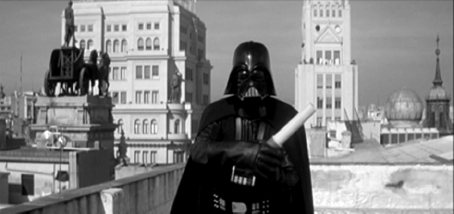
‘Long Live the Republic!’: Charly (Eduardo Artuña) takes his stand as Darth Vader on a Madrid rooftop with the apocalyptic BBVA horses in the background in Common Wealth.
Some time later Julia sees a newspaper ad from a Jedi who needs a princess and recognises that it is from Charly. She figures out that the meeting place is a Madrid bar and reunites with him there. While tipping the waiters handsomely with the old bills, he tells Julia about the suitcase exchange. Charly and Julia dance as the local bar crowd joins in and celebrates their good fortune.
In significant ways Common Wealth returns to the successful mise-en-scène and aesthetics of Day of the Beast. For one, both films exploit enclosed spaces to manipulate the language of the thriller genre. Scenes of Day of the Beast are set in Rosario’s bleak rooming house as well as in Cavan’s luxury apartment, just as Common Wealth takes place primarily inside the apartment building. For another, both Day of the Beast and Common Wealth allude extensively to Hitchcockian scenes staged at heights.
In addition, both Day of the Beast and Common Wealth critique unfettered consumerism, as Spain expanded in the early years of its European Union membership and easy credit led to rampant building. Fittingly, no character in Common Wealth is depicted as blameless or devoid of avarice. The film’s topic seems prescient in the Spanish economic real estate downturn post-2008. During the boom in Spain many apartments were renovated with cash, especially pesetas from the underground economy that had been hoarded. To change them into Euros through official channels would have exposed their owners to government scrutiny and taxes. In Common Wealth the MacGuffin, a 1950s-style suitcase full of pesetas, is as well conceived and critically astute as was Perdita Durango’s cargo of foetuses. The dark humour and critique of consumerism in Common Wealth also draws on the Franco-era films of Marco Ferreri, El cochecito and El pisito. In those films families coveted and fought over consumer possessions, a motorised wheelchair and a flat respectively.
The tour de force rooftop chase in Common Wealth extensively copies the aesthetics, if not the depths, of the romantic relationship, of the Mount Rushmore scene of North by Northwest. The citations were noted in the Spanish and international press. José Enrique Monterde in his review ‘Los “quiméricos inquilinos” de Álex de la Iglesia’ (‘The “chimerical tenants” of Álex de la Iglesia’) in Dirigido observed that Hitchcock was in ‘extreme close-up’ in the mise-en-scène of Common Wealth and that the final chase emulates the finale of North by Northwest (2000: 32).
Common Wealth adapts Hitchcockian aesthetics to the Spanish situation. North by Northwest is Hitchcock’s most American movie since it envisions the US on a gigantic scale, open to the future. The open plains never end and Mount Rushmore depicts humans as mountains. The contrast in scale is similar in Common Wealth as Julia emerges from the apartment building to walk across the sunlit roof on the Madrid skyline. This was a successful commercial move as well. De la Iglesia showed that he could create a spectacle. Like Hitchcock in all of his scenes staged on heights, De la Iglesia built a huge production set of the rooftop in addition to filming on the actual BBVA building. Spectacular effects that convey increasing danger and suspense were created through editing, particularly to close-ups and point-of-view shots. In Common Wealth one neighbour dies by falling off a flagpole over the building’s entrance to land at the feet of American tourists carrying a common guidebook.
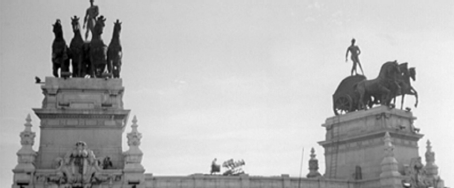
Julia (Carmen Maura) emerges from her apartment to walk across the roof between the monumental statues of the BBVA in Common Wealth.
Movies show us what we cannot normally see. For example the decisive moment when Cary Grant implores the bad guy to help him save Eva Marie Saint. We see the whole panorama of the modern house and the valley behind on a diagonal in the frame that indicates tension. Then the film cuts to show the bad guy step on Grant’s hand, slip and fall down the mountain, breaking the coveted pre-Colombian vessel with film inside. In Common Wealth De la Iglesia reverses the confrontation and unlocks the Latin film inside North by Northwest. First the crazed Ramona and Julia are aligned in a diagonal that shows the danger of Julia’s situation as she dangles from the front hoof of the equestrian statue. Then Ramona demands that Julia admit that she is as avaricious as Ramona. She commands: ‘Say that you’re like me. Say it.’ When Julia refuses and throws the suitcase to her, Ramona falls to her death. Although her fall, breaking through several clotheslines, and bouncing off roofs recalls an improbable cartoon sequence, Ramona’s death, ‘like a flower’ as De la Iglesia says on the DVD track, ‘not my idea’, recaptures the serious tone, and recalls a similar overhead shot of Julia exhausted on the checkered floor in the attic where she had located the money. The original citation is both Hitchcockian and Latin American, for both images in Common Wealth reference Juanita’s death in Topaz, seen from above splayed out on a checkered floor. In Common Wealth Julia’s swoon foreshadows Ramona’s death. As discussed previously, Almodóvar in Flower of My Secret also quoted this same image from Topaz.
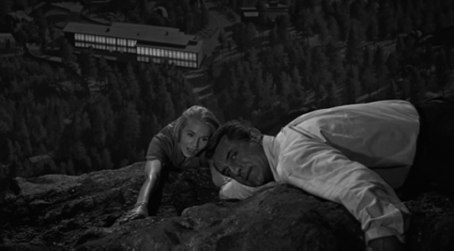
On the precipice of Mount Rushmore, Roger Thornhill (Cary Grant) appeals to the bad guy Leonard (Martin Landau) to help him pull Eve (Eva Marie Saint) up in North by Northwest.
In Common Wealth Julia Carmen Maura) dangles from the front leg of the equestrian statue as her mad neighbor Ramona (Terele Pávez) approaches her.
In Common Wealth Ramona demands of Julia, ‘Say that you are like me. Say it.’
In Common Wealth the dead body of Ramona is arrayed like a flower whose center is the suitcase of cash which caused her fall.
Another allusion to Topaz’s ‘flower shot’: Julia lies exhausted on the checkered floor in the attic where she had located the money in Common Wealth.
Common Wealth changes the conventional morality of North by Northwest to a darker view. In that film good and evil are clearly demarcated. When asked to show respect for human life by Grant the good guy, the bad guy steps on his hand. In contrast, Julia only has to show, and does, that she is not motivated purely by money. Some critics ascribed the same diminished standards to the movie itself. Monterde found the film itself vapid and too commercial, calling it with disdain and considerable rhetorical flourish ‘ese guiñol esplendoroso y comercial pero a la postre excesivamente vacío’ (‘that splendorous and commercial, but in the end excessively empty puppet show’) (2000: 33).
Fake money and a joker’s card scatter like confetti over the Madrid skyline in the final shot of Common Wealth.
Just as we can go to Mount Rushmore but cannot get Hitch’s view, likewise we can go to the Calle Alcalá in central Madrid, but we cannot get De la Iglesia’s splendid skyline view of the fake money and a joker’s card scattering in the wind like confetti over the skyline in the film’s final shot. These impossible views and the monumental scale of the spectacle show how the two films resemble each other.
Like North by Northwest, Common Wealth debuted at the San Sebastián Film Festival, with similar results at the competition, a Best Actress prize, for Carmen Maura, just as Eva Marie Saint had won for North by Northwest. Though certainly not the physical type of a svelte Hitchcock blonde, Maura’s image evoked Hitchcock’s women as much as humanly possible. She appeared as a blonde and stood out in every scene because of her 1950s-style pink suit, similar to those worn by Kim Novak in light green in Vertigo and Eva Marie Saint in light brown in North by Northwest. Maura was the life of the party, perhaps never more so as during fiesta time as the neighbours hold her up for the money. This was the first film for De la Iglesia with a female protagonist and he turned to Hitchcock for ideas for every aspect of mise-en-scène.
The fake fiesta: Julia is the center of attention in Common Wealth as her neighbors try to get her to hand over the money she has discovered hidden in the building.
VIII. CONSUMED BY VENGEANCE: THE UNFORESEEN CONSEQUENCES OF IMPERFECT CRIMES FROM STRANGERS ON A TRAIN TO EL CRIMEN FERPECTO
Though he cast Carmen Maura once again, for his next film after Common Wealth De la Iglesia turned to a completely different genre, the western in 800 Balas (800 Bullets, 2002). This film tells the story of a former cowboy stuntmen in a failing western amusement park called Texas, Hollywood in Almería, Spain. They fight to keep the park open and its cinematographic memory alive when an executive (played by Carmen Maura) scouts the area as a site for a Disney-style theme park. Through these sad-sack cowboys De la Iglesia continued to refine his reputation for comedy, as well as his obsession with ‘felices perdedores’ or happy losers.23 Moreover in 800 Bullets he resurrected the place of Spain, specifically the southern region of Almería, in world cinema history as the place where both Spaghetti westerns and several top Hollywood films, such as Lawrence of Arabia (1962), Doctor Zhivago (1965) and Patton (1970), were made. In several ways he sets the record straight. By putting Spain back into the history of the western he took vengeance on those who had made it impossible to show Vera Cruz, and consequently to release Perdita Durango in his director’s cut in the US. But it left him still waiting and wanting to make it big in Hollywood some day.24
With his subsequent film Ferpect Crime (2004), De la Iglesia returned to a more familiar Hitchcockian genre, the crime drama. The title directly recalls, with a small transposition of letters, the Spanish title of Hitchcock’s Dial M for Murder, Crimen perfecto, the story of a husband who unsuccessfully plots to kill his wife. In both its plot and mise-en-scène Ferpect Crime, whose spelling was ‘corrected’ to El crimen perfecto (The Perfect Crime) by some distributors and many reviewers of the film, alludes more strongly to another Hitchcock film about a would-be perfect plot that failed, Strangers on a Train.25 In the principal setting of ‘el centro comercial’, or shopping mall, De la Iglesia transposes these tales of vengeance into a broader critique of global consumer culture.
Ferpect Crime tells the story of Rafael González (Guillermo Toledo), a cocky, womanising clerk in the women’s section of a major Spanish department store called Yeyo’s. He makes out with women in the dressing rooms, sells a woman a fur coat she cannot afford and celebrates by having sex with a female clerk after-hours in the store when he provisionally receives his desired promotion to floor manager. But when the woman returns the coat, he insults her in front of his rival Don Antonio (Luis Varela), head of the men’s section who then gets the promotion. Don Antonio fires Rafael. In a fight in a dressing room Rafael kills Don Antonio. Lourdes (Mónica Cevera), an ugly duckling clerk, witnesses the murder but keeps the information to herself in order to blackmail Rafael into being her lover. She acts as Rafael’s accomplice in disposing of Don Antonio’s body, which they cut up and incinerate in the store. Rafael finally becomes floor manager, but Lourdes has the upper hand. She remakes the store in her own image, firing the pretty women whom Rafael romanced and substituting them with her homely compatriots.
Lourdes arranges for Rafael to meet her mother and narcoleptic father at an excruciating dinner at their house. Rafael takes Lourdes on a date at the amusement park. Profoundly embarrassed at being seen by a co-worker with Lourdes and injured when trapped on one of the rides, he buys a plane ticket to get away. When she discovers his escape plan, she visits the policeman who investigated Don Antonio’s death but still says nothing about the murder. Rafael begins to go mad and hallucinate. He talks with Don Antonio, now a smoking green phantasm who not only haunts him but also eggs him on repeatedly in his quest to escape Lourdes’ control. Dressed as a bride she ambushes him with a reality TV show crew at the store. He has to respond live to her wedding proposal. He finally says ‘yes’ to her on camera, although in his mind he says, ‘Yes, I will kill her.’ They marry and Lourdes demands sex on her terms.
Rafael buys DVDs to find out how to rid himself of Lourdes: Buñuel’s Ensayo de un crimen, Isaac-Pierre Racine, Agustí Villaronga and Lydia Zimmermann’s En la mente del asesino (Aro Tolbuknin in the Mind of a Killer, 2002), and, of course, Hitchcock’s Crimen perfecto (Dial M for Murder). When he pays for the films, Crimen ferpecto with its misspelling pops up on the cash register screen. At their home Lourdes shows Rafael designs for her new concept for the store – sad clown clothes – which Rafael must present to the store management. Rafael takes her out to the amusement park again. When they ride the Ferris Wheel and stop on top, she begins to talk about having children. He lures her into leaning out to see a family below. She falls out of the car and is left hanging on. Seeing how many other people, including the police investigator, are watching them he pulls her back into the car.
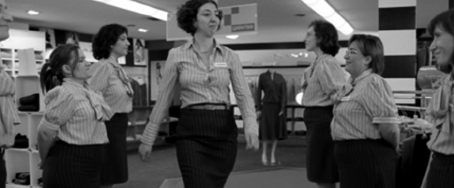
With great satisfaction Lourdes (Mónica Cevera) reviews her newly chosen motley crew of women of all body types in Ferpect Crime.
Bridezilla multiplied: On a reality TV show staged in the department store the emcee asks Rafael, ‘Will you marry Lourdes?’ in Ferpect Crime.
Rafael jumps into an elevator shaft and onto a sexy ad board to escape a fire, a police inspector and Lourdes in Ferpect Crime.
At work in the department store he tricks Lourdes into going into a soundproof room and starts a fire that makes the sprinkler system go off. When the fire spreads rapidly, pandemonium breaks out in the store and on the street. Still Lourdes (Enrique Villén) gets out of the enclosure and attacks Rafael. They struggle. The investigator arrives and arrests both Lourdes and Rafael, but Rafael slips into an open elevator shaft and saves himself by landing on an ad board he had placed there. Everyone thinks he has died in the fire, but he escapes.
Five years later with a new identity Rafael tends his own tie store. He watches the street in front of his store fill with clowns who cheer adoringly as Lourdes exits the department store and slips into a waiting limousine. A huge billboard says ‘Clown Fashion Hits Big’.
Hitchcock’s motifs and irony reverberate throughout this film. One, they hide Don Antonio’s body in plain sight, as a mannequin (a motif in Buñuel’s Ensayo de un crimen) dressed in ski clothes. This recalls Hitchcock’s light comedy, The Trouble with Harry (1955), whose whole plot deals with the hiding of Harry’s body after he dies unexpectedly. Two, the idea that it is not so easy to kill is a theme associated with the prolonged murder of the Russian spy in the kitchen scene of Torn Curtain. After hiding Don Antonio’s body, Lourdes and Rafael belabour the butchering of the body. Three, the film’s title, Ferpect Crime with its misspelling on the department store cash register is a direct citation of Hitchcock’s Dial M for Murder. As we have seen, that film tells the story of a husband plotting to kill his wife, just as Rafael plots to kill Lourdes. In Dial M for Murder, Margot (Grace Kelly) grabs scissors to defend herself from the intruder’s attack. In Ferpect Crime this story is repeated in a flashback to the case of Howard Green, murdered by his wife with scissors. Posters for Dial M for Murder featured the scissors murder. Notably Hitchcock used gigantic props for his film, which Ferpect Crime alludes to in an insert shot of immense bloodied scissors. Finally, and most significantly, Strangers on a Train is repeatedly cited and parodied in Ferpect Crime.

The insert shot of giant bloodied scissors in Ferpect Crime recalls the murder weapon in Dial M for Murder.
To recall, the extensive opening sequence of Strangers on a Train introduced the two main characters by showing only their shoes and legs as they arrive to catch a train. The suave Bruno (Robert Walker), who comes to town with the crisscross plot for murder, wears fancy two-tone wingtip shoes. When Bruno and Guy (Farley Granger) bump up against each other’s shoes under the table of their train car – the ‘footsies’ encounter is shown in a low-angle shot – the whole vengeance plot, which Bruno calls ‘the perfect crime’, is set in motion. Likewise Ferpect Crime introduces Lourdes through her white Camper shoes, which Rafael sees beneath the dressing room door after killing Don Antonio. This point of view shot sets the blackmail plot in motion.
A crisscross first meeting: Bruno’s flashy two-tone shoes touch Guy’s conservative wingtips under the table in Strangers on a Train.
First impression through shoes: Rafael spies Lourdes’ white Camper shoes under the dressing room door after he has killed Don Antonio in Ferpect Crime.
Insert shot of Bruno showing off his gaudy tie, a gift from his mother, to Guy when they first meet in Strangers on a Train.
Ferpect Crime parodies Hitchcock’s characterisation and classic narration for humorous effect using the white shoes as a leitmotif. Lourdes’ shoes, though white like Bruno’s and ostensibly in fashion, are as ugly as she is. Moreover, the effect is heightened with a first mistaken sighting of white shoes on a red carpet. Rafael accosts a woman shopper in the store wearing similar white Camper shoes before finding out that Lourdes is his ‘guardian angel’. They meet in the cafeteria. In a point-of-view shot he checks her shoes out under the table. Even the epilogue of Ferpect Crime references fashion in Strangers on a Train, since Rafael survives by selling ties, a piece of clothing intimately associated with Bruno. To recall, when Bruno first meets Guy on the train, he showed off the loud tie his mother gave him.
It is worth pausing for a moment, given that we have brought into the discussion the archetypal obsession of the gay Bruno with his mother, to consider gender representation in Ferpect Crime. As Boris Izaguirre in his chapter ‘Pasajeros en un mismo tren’ (‘Passengers on the same train’) notes about a subsequent encounter between Bruno and Guy:
They are lovers in the night, the criminal image of gayness, which relates perfectly to the late Victorian education of Hitchcock. Caught in the dark, their attraction for each other is confirmed. And Hitchcock knew how to photograph it better than anyone. (2005: 100)
Perhaps because of Hitch’s Victorian moral limitations, homoeroticism makes Strangers on a Train the beautiful, engaging and witty film that it is. Heterosexuality does not fare as well in Ferpect Crime. The stereotyping of women either as bimbos or sex-crazed losers, brought to a climax in the emphatic and unrelenting cruelty in representing Lourdes, makes the film misogynistic and often alienating for a female spectator. Many critics, including Tania Modleski in The Women Who Knew Too Much: Hitchcock and Feminist Theory (2005), have interpreted Hitchcock’s films in gender terms. Modleski in particular strives to ‘save his female viewers from annihilation at the hands not only of traditional male critics but of those feminist critics who see woman’s repression in patriarchal cinema as total, women’s “liking” for these films as nothing but masochism’ (2005: 122). For Modleski, the role of Hitchcock’s daughter Patricia as Barbara Morton in the film, who when she appears looks like the dead Miriam and hence evokes guilt in the villain, is key, for her haunting presence puts ‘the blame for crimes against women where it belongs’ (ibid.). In Ferpect Crime this blame should not only fall on Rafael but would be directed at him by the gaze of Lourdes’ lookalikes. Following Modleski’s critical approach, we need to examine how guilt both enters his mind and how it slips away.
Ferfect Crime most significantly evokes Strangers on a Train in the mise-en-scène of the amusement park that they share. To recall, in that film Bruno kills Guy’s homely wife Miriam in an amusement park. It is also in the amusement park that the most iconic scene of surprise, cruelty and ironic humour takes place when Bruno chats with a young child, then pops his balloon on purpose. Later Bruno is killed in the same amusement park by a runaway merry-go-round after a fight to the death with Guy. This sequence was Hitchcock’s tour de force in the film for his combination of live action and shots of architectural models. In Ferpect Crime Rafael has vengeance and murder on his mind, and perhaps Bruno’s success, when he takes Lourdes to the amusement park the second time. Riding the Ferris Wheel to the top, Lourdes slips out of their car, but Rafael pulls her back in. The rescue is almost more of an accident than Lourdes’ fall. Women in the other cars, like Patricia Hitchcock’s character in Strangers on a Train, stare at Rafael in horror and generate a sense of guilt in him. The repetition of the Hitchcockian archetype of a climatic scene on heights, in De la Iglesia’s most widely-circulated films, Day of the Beast, Common Wealth and Ferpect Crime, shows the sustained importance of Hitchcock in De la Iglesia’s film over his commercial career.
In his review, ‘El Crimen Perfecto: An Imperfect Crime Comedy’, Roger Ebert also noticed ‘hints of Hitchcock’ in the film. However for Ebert the film failed as comedy:
Second time around: in their second visit to the amusement park Lourdes falls out of the Ferris wheel car and grasps toward Rafael in Ferpect Crime.
The endless view of consumerism: Rafael surveys the main floor of Yeyo’s department store in Ferpect Crime.
‘El Crimen Perfecto’ has energy, colour, spirit and lively performances, but what it does not have are very many laughs. In a month that has seen ‘The 40-Year-Old Virgin,’ a wonderful comedy about romance in retail, this one seems oddly old-fashioned; it has a 1950s feel. (2005)
Ferpect Crime did mine 1950s aesthetics through Hitchcock’s films of that period, but with less genuine humour and certainly little romance.26 At the same time as Ferpect Crime parodied global consumer culture and archetypal dreams such as spending a night in a perfectly appointed department store, it became caught in its own web.27 When multiple location shots of major department stores in central Madrid, Barcelona and Sevilla were seamlessly edited together, urban Spanish viewers were sutured into the film in another vortex of perspective to recognise their own shopping habitat on screen. Unlike De la Iglesia’s earlier urban locations, however, these sites were all too common and mass produced and, hence, the film only reaffirmed its status as a commercial object through the mise-en-scène.
With a budget approaching five million Euros, Ferpect Crime was an expensive movie for the Spanish industry and, though it disappointed some critics, it performed well at the box office. Moreover, it opened in more international markets than De la Iglesia’s previous films had, perhaps due to the accessible combination of Hitchcock and shopping.
IX. THE MAN WHO KNEW TOO MUCH AND BLOGGED ABOUT IT: THE ROOFTOP CHASE OF BLACKMAIL AND HITCHCOCK’S HERMENEUTICS IN THE OXFORD MURDERS
Does the perfect crime exist? For years, writers have speculated on this idea, time and again, and murderers, too. Some even managed to put the idea into practice. Like the case of Howard Green, in London. (Seldom in Voice Over, Exterior Flashback. Howard Green. Street – Day 63, Script of The Oxford Murders, 204.)28
Coming off his homage to Strangers on a Train, Álex de la Iglesia took on another story of a perfect crime, Guillermo Martínez’s novel Los crímenes de Oxford (2004), a mystery thriller with a mathematical theme. The Argentinean novel had been a best-seller in its original Spanish version as well as worldwide in translation. Gerardo Herrero, a Spanish producer with a strong international reputation – he was also responsible for J.J. Campanella’s El secreto de sus ojos (The Secret in Their Eyes (2009) – encouraged De la Iglesia to take on the project, a primarily European co-production funded by Eurimages, NBC Universal and Telecinco. To be shot on location in the UK this film would be De la Iglesia’s second attempt in English. Its $10 million budget doubled what he had for Ferpect Crime. Although far from the scale of a Hollywood blockbuster, it still gave him the chance to put the partially aborted Perdita Durango behind him and assume a more global profile.
In an interview with María Güell at the film’s Spanish opening in Barcelona, published in ABC-Sevilla, De la Iglesia adamantly dismissed any hint that The Oxford Murders was ‘un encargo’, or contract work (Güell 2008: 76). Taking three years preparation for filming, De la Iglesia wrote the script himself with his long-time collaborator Jorge Guerricaechevarría. Asked in the same interview ‘What references did you find useful for weaving the plot?’ he replied, ‘Mankiewicz, Hitchcock … Everything is in my head.’29 We will explore the numerous Hitchcockian references and what they meant to De la Iglesia at a more mature stage of his career. Symbolically, De la Iglesia’s crossover move to the UK recalled the late career shift of Hitchcock, who returned to the UK to recharge his career with Frenzy. Nonetheless, the challenges posed and the eventual solutions were far more international than those Hitchcock faced in his homecoming. Like Alejandro Amenábar who directed the megastar Nicole Kidman in his first English-language film The Others (2001) at a critical moment in her career when her marriage to Tom Cruise was ending, De la Iglesia was called on to help Elijah Wood, best-known for playing Frodo in The Lord of the Rings series (2001, 2002, 2003), transform his image from asexual idol of adolescent fantasy to mature dramatic actor able to pull off a sex scene. De la Iglesia cast the Spaniard Leonor Watling, known internationally for her role as the sleeping beauty in Almodóvar’s Talk to Her, as Wood’s character’s romantic interest for his sexual awakening. The sex scene, slurping spaghetti off of Watling’s body, which restages the kiss scene from Disney’s The Lady and the Tramp (1955), helped him make the leap from G-rated to R-rated cinema. Importantly, like Amenábar with The Others, De la Iglesia brought his own Spanish technical crew on board for the project.
The Oxford Murders tells the story of Martin (Wood), an American grad student who comes to Oxford with hopes of studying with Professor Seldom (John Hurt), a famous mathematician, now retired, whose work compared mathematical series and serial murders. Martin meets Lorna (Watling), a nurse, playing squash and falls in love with her. When Seldom gives a public lecture, Martin asks him a question and is ridiculed. Later Seldom and Martin together stumble upon the murder of Martin’s landlady, Mrs. Eagleton (Anne Massey), whose daughter Beth (Julie Cox), a cellist, took care of her. Seldom tells the police he had received a note that suggested that the murder was the first of a series. Cryptic mathematical clues lead to several other murders that the police investigate. First, a terminally ill patient in the bed next to that of Seldom’s incapacitated and mad former student is found dead. Second, at a Guy Fawkes Night concert, which both Martin and Seldom attend to hear Beth play, a percussionist grabs his throat and dies. Finally, chased by Martin and Seldom, Frank (Dominique Pinon), the father of a child who needs a transplant drives and crashes a busload of mentally incapacitated children, killing several in a desperate attempt to get the organ his daughter needs.
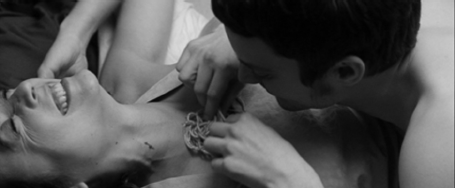
An ‘R’ version of the kiss scene of The Lady and the Tramp: Martin (Elijah Wood) slurps spaghetti off of Lorna’s (Leonor Watling) body in The Oxford Murders.
Martin goes to the airport to leave on a vacation with Lorna, but becomes engrossed in a photo of the first crime scene that reveals that Mrs. Eagleton’s scrabble word ‘Kreis’ (‘circle’) had given Seldom the idea for the first symbol and the diversionary theory. Martin misses the flight but Lorna leaves on it. Shortly after Martin meets Seldom in the gallery of reproductions of the Victoria and Albert Museum. Seldom confesses that he planted clues to suggest that the deaths were connected to cover for Beth, who murdered her mother to be free to love Martin.
The moral dilemmas posed by this story required a more serious, dramatic tone than De la Iglesia’s previous films had demanded. As in Hitchcock’s Blackmail, the moral message of the film, or ‘la vuelta moral’ (‘moral twist’) as De la Iglesia wrote regarding the film’s final museum scene, was that no one is blameless:
You have to pay to play. The most surprising thing is that some people believe, or more justly, that some of us believe, that we are free of guilt, and it isn’t so. We aren’t witnesses to a drama; we are integral pieces in the game of suffering, and capable of knowing it and taking it on. No one is on the other side of the window. The very act of observing transforms reality and converts you into a protagonist, into the one guilty of the crime. No one is innocent. (De la Iglesia & Guerrichaechevarría 2008: 69)
Befitting the philosophical subject matter the film had the most serious tone, and fewest examples of humour, of any of De la Iglesia’s movies. His comic spirit and characteristic sardonic wit found an outlet in his blog, quoted from above. After the film’s release he published the blogs, entitled ‘Blasfemando en el vórtice del universo’ (‘Blaspheming in the vortex of the universe’), along with Spanish and English versions of the script, some storyboards and copious photos. To read the blog, you have to turn the book over and upside down. In a typically irreverent post, he complained that in Elijah Wood’s contract for the film three pages specified how many shots of Wood’s posterior the director could take and how much he could show (De la Iglesia & Guerrichaechevarría 2008: 5).30
Most significantly De la Iglesia blogged about how both the budget and producers limited his artistic vision. Over the years he had learned to use a full range of cinematographic tools. He now knew almost too much about what was possible. For instance he was vetoed in using spider-cams to film a shot between two buildings, noting ‘We only have enough money for cucaracha-cams’ (De la Iglesia & Guerrichaechevarría 2008: 24). In his opinion, working on the Harry Potter films (2001, 2002, 2004, 2005, 2007) had spoiled his British technical crew into expecting too high a budget. In another post he mocks the excessive caution and control that security inspectors exercised on his use of pyrotechnics and his choice of camera placements on heights, one of the signature Hitchcock shots De la Iglesia often cited. For The Oxford Murders they only allowed him to shoot halfway up a building. In coarse language he recounts his exasperation:
In Greenwich five guys came with us to oversee the security measures for the shoot. We had to do a test of the fireworks, and the idiots looked at the stones to see if they got hot from the sparks. It was so ridiculous they gave us permission. But in the matter of placing cameras on the roofs, it’s like they keep plucking hairs off their genitals with tweezers. They’re almost giving me a heart attack. Later a leak turned up. Well, it seems the matter has turned into something terrifying because it’s back to being a question of security. And what if the roof falls? It made me laugh, but the location shot depends on that stupidity. The director’s assistant says that he can’t risk his job for a leak … I understand that they want to control everything, but you don’t make movies that way, you make collections of picture cards. (De la Iglesia & Guerrichaechevarría 2008: 26)
The invitation to look on high was already in the novel in the concert scene. In some ways the novel itself was already cinematic, that is, either evoking well-known filmic narratives or perhaps even written with an eventual adaptation to the screen in mind, as several other novels in Spanish have been, such as those of Arturo Pérez Reverte.31 In the novel The Oxford Murders, the way a triangle player dies at a concert recalls the concert hall dénouement of The Man Who Knew Too Much.
De la Iglesia continued to think of Hitchcock to inject suspense in the filmic adaptation. However, he unfortunately made a joke out of the concert scenario. He set the scene on Guy Fawkes Day. When the percussionist struggles and falls dead, every one looks up to search for an assassin on high. A rooftop chase ensues. Martin, Seldom and the police follow a costumed Podorov (Burn Gorman), Martin’s resentful officemate, up stairs and across the rooftops. The shots from this chase scene, of a spiral staircase, recall the spiral motifs of climatic chase in Hitchcock’s Blackmail at the British Museum, as well as, of course, Vertigo. To recall, in Blackmail the suspect Tracy (Donald Calthrop) runs through the reading room with its desks set out in a spiral pattern; he proceeds through the maven of corridors to climb out onto the dome. Podorov carries a long wrapped package, which the viewer thinks could contain a rifle. When they finally pin him down on the roof they open the package to reveal an innocuous banner with the irreverent word ‘Bastards’. The effect is to deflate the tension rather like a gun shooting out a flag that reads ‘Bang’. De la Iglesia embellished The Oxford Murders with Hitchcockian motifs, particularly from his British period. But although humour, especially irony, abounds in the script, most of it falls rather flat in the film.
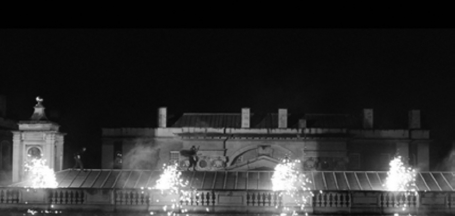
After the percussionist dies at a Guy Fawkes concert, Seldom, Martin and the police chase a suspect, a costumed Podorov, across the rooftops as fireworks explode in The Oxford Murders.
Chase on a Hitchcockian spiral staircase in The Oxford Murders.
Climatic chase in the rotunda of the British Museum in Hitchcock’s Blackmail.
One particular humorous situation alludes to Hitchcock’s Frenzy, which is also evoked on a more sombre note with the close-up of the face of the first victim Mrs. Eagleton (Barbara Leigh-Hunt) in The Oxford Murders. It resembles the morbid shot of the strangled Brenda. A closer citation to Frenzy, in the humorous spirit of Hitchcock, is when the police inspector offers his own theory that the symbols they have found associated with the first two cases look like a conventional menu, starting with soup, then fish, so that the third would be dessert. To recall, one of Frenzy’s funnier running gags is the foreign-inspired dinners the police inspector’s wife serves him as he tells her about the case. He prefers plain food. Notably one day she announces ‘soupe de poisson’ (fish soup). Finding it too exotic for his liking, he dumps his serving back into the pot when she goes into the kitchen. In the same spirit the mathematical ruminations of Seldom and Martin, with their foreign mumbo jumbo, are all too pretentious for the plainspoken Inspector Peterson (Jim Carter) in The Oxford Murders.
In his blog entitled ‘Five minutes of free association’ as he plans the next day’s shoot of the final scene at the Victoria and Albert Museum, De la Iglesia writes both specifically and philosophically on the importance of Hitchcock to his own vision:
Let’s see, it’s my last day in the museum. I have to film two traveling shots, of Martin and Seldom. I prefer to use tracks rather than the steady cam, but since we can’t move anything, because a hundred alarms go off, I can’t lay tracks down. So I’ll let it go. After that, enter into the third space, where Seldom sits down, in front of the Portico of Glory. General shot, and cuts, but Kiko says not at once, OK, as God wills, we’ll have to take care of that. Fine. Tracking shot: Martin gets up and close-up when Seldom calls him. Maybe I’ll look for another way to do it, but finally this is terribly effective, it’s what fits. Think about it. Super close-up in the final phase: lips, ear, like in The Man Who Knew Too Much. Hitchcock isn’t just a director, he’s a way of thinking, an attitude. It’s like belonging to a group of Dwarves, it’s a hermeneutics. One doesn’t try to write like Jung, or Eliade. The point is that you are CONVINCED that they are on the way to the truth, YOU PARTICIPATE in their way of understanding the world. Weltanschauung, that’s the concept. He isn’t a director, he’s a way of thinking. (De la Iglesia & Guerrichaechevarría 2008: 70)
In The Oxford Murders De la Iglesia used more close-ups than he had in any previous film. In the museum finale first there is a sequence of extreme close-ups, of Seldom’s lips, then Martin’s ear and eyes. As we see from his blog entries, Hitchcock, and specifically The Man Who Knew Too Much, inspired De la Iglesia to see the close-up as the most efficient aesthetic solution to telling a mystery story about murders foreshadowed. In Marrakesh the dying Louis Bernard (Daniel Gelin), an FBI agent costumed as an Arab, whispers his final secret into Dr. Ben McKenna’s (Jimmy Stewart) ear, that a statesman will be assassinated in London soon.
The Oxford Murders challenged De la Iglesia to adapt a global bestseller and direct major English-language stars. In Spain the film was a big success and topped the box office in 2008. The Oxford Murders received six nominations for the 2009 Goyas, including Best Director and Best Film, but won for more minor categories – score, editing and production. Even though this was the first time a dubbed English-language film competed for the major prize in Spain, it did not make the language breakthrough that Danny Boyle’s multilingual Slumdog Millionaire (2008) did in winning the Best Motion Picture Academy Award in 2009. In the UK, moreover, The Oxford Murders won little praise for innovation or artistry. Many online critics savaged it.32 Among newspaper and journal reviews, Carlos Boyero for El País was fairly typical when he wrote, ‘This intelligent movie intrigues me, but I don’t love it.’33 In Fotogramas the ‘pro’ or in-favour-of review by Fausto Fernández highlighted British Hitchcock: ‘It vindicates Alfred Hitchcock, but not the most cerebral one, but the clever, ironic, British father of McGuffins’; whereas writing in ‘contra’, or opposed to, Jordi Costa put the blame on the novel itself as a ‘a scandalously simple enigma’. In the US The Oxford Murders was launched in 2010 first for Xbox Live, Playstation, Amazon, Vudu and Pay Per View, before opening for theatrical release.
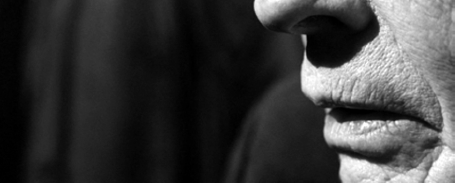
The techniques of The Man Who Knew Too Much: extreme close-up of Seldom’s (John Hurt) lips in The Oxford Murders.
Repetition of the techniques of The Man Who Knew Too Much: extreme close-up of Martin’s (Elijah Wood) eye and ear in The Oxford Murders.
Final words in extreme close-up in The Man Who Knew Too Much: the dying, costumed Louis Bernard (Daniel Gelin) whispers his secret to Dr. Ben McKenna’s (Jimmy Stewart).
The aesthetics of The Oxford Murders drew on the close-ups of The Man Who Knew Too Much, the mise-en-scène of Blackmail and the humour of Frenzy among many other references. In his production blog De la Iglesia articulated more extensively that he had ever done previously his debt to what he called Hitchcock’s hermeneutics – that is, an efficient way of drawing the spectator into the film. Everyone becomes caught in a moral web in The Oxford Murders even without spider-cams. De la Iglesia’s production blog shows not only how media has evolved but also how De la Iglesia himself endeavours to manipulate and exploit his public image as Hitchcock did.
X. A PUBLIC ROLE OR PERSONA: THE PRESIDENT OF THE ACADEMY ON STAGE, ON TV AND ON THE WEB
Many factors – early adopter status, commercial success and a strong fan base, respect and knowledge of film and media history, a sense of humour – led to De la Iglesia’s election as the President of the Spanish Cinematographic Academy in 2009.34 One of the duties of the President is to organise and preside over the Goya award ceremony. To generate interest in the TV broadcast, which was losing viewers in recent years, he redesigned the Academy website, using his own drawings and distinctive lettering style, and added online polls. At the actual gala, he gave a stirring address defending the rights of creators. When he exited the stage he gestured and exclaimed, ‘A la Fuerza,’ roughly evoking Star Wars’ ‘May the force be with you.’ Later he would return to the stage to bring off a surprise coup. He managed to stage the reconciliation of Almodóvar with the Academy and sneak him on stage to receive a standing ovation during the Goyas ceremony. To accomplish this coup, he deployed Hitchcock.

‘The Force Be with You!’: Álex de la Iglesia at the 2009 Goya ceremony.
Almodóvar had left the Academy ostensibly to protest voting procedures five years earlier. His absence also responded to a personal snub of his work and more generally to the Academy’s inefficiency in promoting Spanish cinema globally. To carry off the surprise appearance of Almodóvar, De la Iglesia hid him in a nearby hotel under the alias Roger Thornhill, Cary Grant’s name in North by Northwest. Almodóvar and De la Iglesia share a sense of humour and irony, as well as good timing. Fundamentally they share a desire to transform Spanish cinema according to Hitchcock’s model and achieve artistic and commercial success as Hitchcock did. De la Iglesia has become the most public face in Spain of this transnational project. For this reason the Spanish Ministry of Culture awarded him the 2010 Premio Nacional de Cinematografía (National Film Award) for lifetime achievement.35 The official proclamation by Ángeles González-Sinde, Minister of Culture, cited his ‘innovative and transgressive professional trajectory’ that had ‘enriched the language of our cinema’ as well as his negotiating efforts as President of the Academy to bring together the Spanish film community and the general public (2010: 66465). Whether he was more transgressor or conciliator in his public role would soon be tested.
For approximately a year public debate raged over the proposed ‘Ley Sinde’ or Sinde Law, as the Sustainable Economy Act was known after Ángeles González-Sinde. The law set out new provisions designed to fight internet piracy. The web community, which aligned with De la Iglesia’s fan base, had objected that the Sinde Law stipulated excessive penalties for violations of intellectual property rights when in Spain there were not sufficient legal avenues to download content. De la Iglesia had tried but failed to broker a truce between content creators and users, both through face-to-face meetings with film exhibitors and distributors, and through an active presence on Twitter. When it became clear that the major congressional parties would approve the law, De la Iglesia announced he would resign as President of the Academy after presiding over the Goya gala. How he would perform at the ceremony was much anticipated. That night he gave a passionate speech, which was the hit of the telecast. De la Iglesia defended his vision of Spanish cinema in the new media world: ‘The rules of the game have changed; the internet is the salvation of our cinema’ (De la Iglesia 2011). González-Sinde, who was in the front row of the audience, made for a perfect cutaway shot as he spoke.
XI. CONCLUSIONS: REMAKES, TELEVISION AND HITCHCOCKIAN HEIGHTS IN BALADA TRISTE DE TROMPETA AND LA CHISPA DE LA VIDA AND A TRANSNATIONAL LATIN JOURNEY
For many decades Hitchcock was known to more people from his TV series Alfred Hitchcock Presents than his movies. In a similar manner De la Iglesia’s many television projects, Plutón B.R.B Nero (2008–9), a 24-episode-long sci-fi series and a made-for-TV horror film full of monitoring devices, La habitación del niño (The Baby’s Room, 2006), part of a series ‘Películas para no dormir’ (‘Films to keep you awake’), have bolstered his cultural profile or ‘Q score’. As we have seen in this chapter, the primary role of ‘new’ media, whether TV or the web, as the transmitter of culture and history has long preoccupied and intrigued De la Iglesia since his first short Killer Mirindas. He returned to this obsession in Balada triste de trompeta (The Last Circus, 2010) and in La Chispa de la vida (As Luck Would Have It, 2011). Both films, which were far more overtly political than his previous work, showed and critiqued how television marked life in Spain.
The Last Circus tells the story of a love triangle in which Natalia (Carolina Bang), a young trapeze artist, chooses between rivals Sergio, the Happy Clown (Antonio de la Torre), an attractive but abusive lover, and Javier, the Sad Clown (Carlos Areces), the initially timid friend. The film, which functions as a political allegory of the two Spains, Nationalist and Republican, depicts the brutality of two historical periods: first, the Spanish Civil War (1936–9) when the Republican Army invades the circus and enlists Javier’s father; and second, the final years of Franco’s dictatorship (1973–5) when Javier witnesses the assassination by a car bomb of General Carrera Blanco, President of the Government and anointed successor to Franco. This act is considered the most significant terrorist act by ETA, the armed Basque separatist organisation. Javier follows its rebroadcast on TV when he visits and shoots up a roadside bar. For the first time in his film career De la Iglesia represented ETA violence openly on screen. As with the Tejero coup in Dying of Laughter, De la Iglesia showed the role of the media in creating historical memory.
As Luck Would Have It focuses on a later period, the extreme economic and political crisis that hit Spain after 2008. Roberto Gómez (José Mota), an unemployed advertising executive who thought up the Coke slogan ‘La chispa de la vida’ (‘the spark of life’), cannot get another job. He has a catastrophic accident that he turns into a media spectacle in order to provide for his family, especially his wife, played by Salma Hayek. Until Hayek, no major Latin American star had appeared in De la Iglesia’s films. Since her appearance his movies have been given prominent slots in Latin American film festivals. As Luck Would Have It closed the 2012 Festival of Cartagena de las Indias, Colombia and the first Panamanian International Film Festival. Las brujas de Zugaramundi (Witching and Bitching, 2014) opened the 2014 Panamanian Film Festival. Furthermore, in 2014 he shot Messi, a documentary on Lionel Messi, in Rosario, Argentina.
At a mature stage of his career, De la Iglesia is also conscious of his impulse, which he traces to Hitchcock, to remake or perfect his films:
This is something that happens to a lot of directors, we’re always making the same movie. Hitchcock, for example, seems to be trying to achieve the perfect movie throughout his career, such that he remakes the same movie over and over. It’s an understandable goal, which Hitchcock takes to the limit when he repeats movies, such as The Man Who Knew Too Much, and which Hawks imitates in Rio Bravo (1959) and El Dorado (1967). (Angulo & Santamarina 2012: 156)
De la Iglesia observed that he repeated his formulas, which always mine television history, in the following pairs – Mutant Action in his sci-fi TV series Plutón B.R.B Nero (ibid.), Dying of Laughter in The Last Circus (2012: 221), and Day of the Beast in As Luck Would Have It (2012: 184).
Although his own authorial style is now well developed and easily recognisable,36 certain elements of Hitchcock’s artistry remain part of his stock and trade, none more so than their shared obsession with heights in iconic settings, which we have seen in this chapter. As De la Iglesia explains in regard to his own repetition of this scenario in Day of the Beast, Common Wealth and The Last Circus: ‘when you take the characters to the Heights, it’s as if you raised them up to Olympus, as if you purified them. Unconsciously the spectator also feels that sensation and believes that when on high the person is telling the truth and can’t lie’ (Angulo & Santamarina 2012: 238). The climax of The Last Circus unfolds at the Valle de los Caídos (Valley of the Fallen), the gigantic monument on the outskirts of Madrid that Franco had built to commemorate the Spanish Civil War. From its inception it has enflamed the passions of the two Spains.37
In As Luck Would Have It, the catalytic event of the story occurs when the protagonist falls from a high point of the Roman amphitheatre in Cartagena and impales himself on an iron bar, where he remains immobilised for the whole film. The fascination for the set, which is generally technically complex, and often filmed in a manner that reveals multiple planes of details, underscores most of his filmic production. Although he has not been able to make the leap yet to film a Hollywood blockbuster, De la Iglesia’s characteristic genre mix, which in the spirit of Hitchcock is always underpinned by a unique sense of humour, has proved commercially viable and increasingly attractive to European and Latin American audiences.38
NOTES





